Ecuador 2010
Saturday, July 17, 2010, Green Valley Lake, CA, about 1000 PDT
(GMT-7)
The second trip for this summer is less than a week away. We're
going back to Ecuador to gather support material for Sandy's
Master's Thesis in Archaeology.
There is no field school in Ecuador this year. The UCLA and
Foothill College field schools are being held in Belize
instead.
Sandy's thesis is that Inka or even pre-Inka trade routes may be
determined through the sourcing of obsidian. She has gathered some
obsidian samples for X-ray florescence analysis (to determine
chemical composition) but she needs more samples that are stored in
the PAP (Pambamarca Archaeological Project) archives in
Ecuador.
To that end, we will be traveling to Ecuador on July 22nd and
returning on August 8. We don't have hard set plans on where we
will be staying though. We could spend some time at the Hacienda
Guachala or perhaps stay with other project members that will be
there at the time in some rented house in Cangahua. We will
probably not rent a car, but instead rent a taxi for the days that
we need transportation. Taxis there are inexpensive and regular
rental cars are expensive.
Thursday, July 22, 2010, Quito, Ecuador, about 1630 EST
(GMT-5)
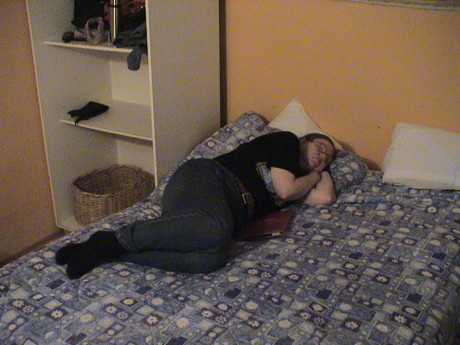 After a true red-eye,
we've made it to Quito. Our LACSA flight left Terminal 2 at LAX at
about 0230. I got a little sleep before we left the house and a
little more on the airplane on the first leg to San Jose, Costa
Rica. We had an hour layover and then a 2 hour flight to Quito.
Then a $7 cab ride to the Hostel Alcala in the Mariscal district,
not far from the places we stayed last year. We grabbed
an early dinner at Rodriguez, an inexpensive and very good taco
place a few blocks away. Then I settled down to write in this page
and Sandy crashed. She had the help of a beer.
After a true red-eye,
we've made it to Quito. Our LACSA flight left Terminal 2 at LAX at
about 0230. I got a little sleep before we left the house and a
little more on the airplane on the first leg to San Jose, Costa
Rica. We had an hour layover and then a 2 hour flight to Quito.
Then a $7 cab ride to the Hostel Alcala in the Mariscal district,
not far from the places we stayed last year. We grabbed
an early dinner at Rodriguez, an inexpensive and very good taco
place a few blocks away. Then I settled down to write in this page
and Sandy crashed. She had the help of a beer.
The plan tomorrow is to get topographical maps at the Institute
Geografico Militar (IGM) and perhaps stop by a bookstore. We also
have to get Sandy's cell phone working and will probably have to
buy some minutes for it.
Friday, July 23, 2010, Quito, Ecuador, about 2000 EST
(GMT-5)
After sleeping for 16 hours we started a busy day. We got
breakfast in the hostel and arranged to stay another day. We met
Eric (a grad student we met last year) at 1000 and caught a cab
($2) to go to the IGM and then hit up a bookstore after another
short cab ride. Then we walked a few blocks along Avenue 12 de
Octobre to the SuperMaxi, a pretty normal supermarket, and bought
water, juice, bread and four bottles of the Ole brand of jalepeno
sauce that I liked so much. It isn't available in the US.
We put the SIM card that we bought last year into Sandy's cell
phone and it seems to work, at least it recognizes a network, but
it needs minutes.
We left Eric at the Jardin del Sol and walked back to our hostel
to drop off our loot. Then we walked around the block to catch some
lunch. We also found a place that sold us $6 worth of minutes for
Sandy's cellphone, that should be about 50 minutes. It appears that
monthly cell phone plans are not too common here, most everybody
uses prepaid plans that cost about the same as the one that I have
in the US.
This hostel is only a couple of blocks from the ones we stayed
at last year, but it is MUCH quieter. There is a water
pressurization pump that runs intermittently right outside our
room, but it didn't seem to be a bother. The room is small, but
adequate. We have internet, TV, a hot shower and a queen bed.
After getting back to the room, we both crashed again. Since we
had a late lunch, we just had some bread and juice for dinner. The
tentative plan for tomorrow is to get up early, catch a cab to the
train station and ride the train to Cotopaxi National Park, about a
3 hour ride one way. Cotopaxi is one of the larger volcanos in
Ecuador.
Saturday, July 24, 2010, Quito, Ecuador, about 1530 EST
(GMT-5)
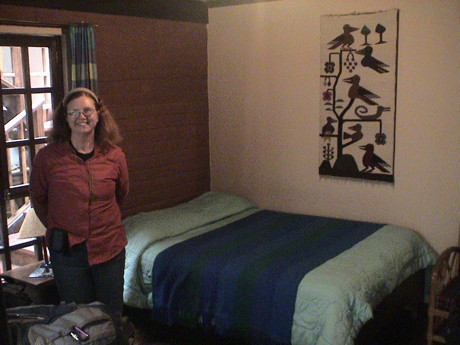 We couldn't
stay at Hostel Alcala for another night as the place was fully
reserved so we moved about a block away to the Hostel El Aurpo.
This place is a only a little more expensive by $6 but it nicer
inside. However Alcala was nice enough.
We couldn't
stay at Hostel Alcala for another night as the place was fully
reserved so we moved about a block away to the Hostel El Aurpo.
This place is a only a little more expensive by $6 but it nicer
inside. However Alcala was nice enough.
We cancelled the train trip when we found out that we would have
to move as we would need to be here to do it. The Cotopaxi train
will have to wait for another day, but probably not this trip.
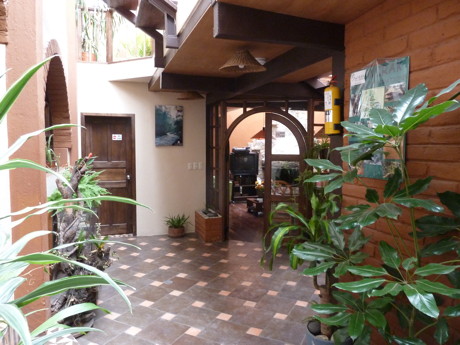 This is the view
looking out our bedroom door. The hostel is very nice inside. At
the end of the hall is a lounge and TV room.
This is the view
looking out our bedroom door. The hostel is very nice inside. At
the end of the hall is a lounge and TV room.
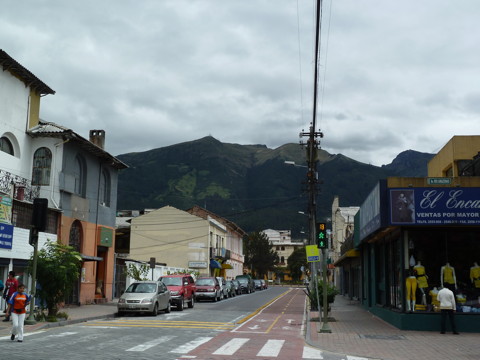 After we checked in, we went to
plan B for the rest of the day. We took a walk to Saturday flea
market near the Banco Central. This is a shot looking west to the
mountain range between Quito and the costal plains. Although it
doesn't show in this photo, the cable car that we rode last year
goes right up that mountainside.
After we checked in, we went to
plan B for the rest of the day. We took a walk to Saturday flea
market near the Banco Central. This is a shot looking west to the
mountain range between Quito and the costal plains. Although it
doesn't show in this photo, the cable car that we rode last year
goes right up that mountainside.
The flea market was no great shakes, it was much smaller than
one at Otavalo. Then we went for another tour of the Banco Central
museum. I understand a lot more about the artifacts that are on
display than I did last year. We were not allowed to take pictures
inside the museum.
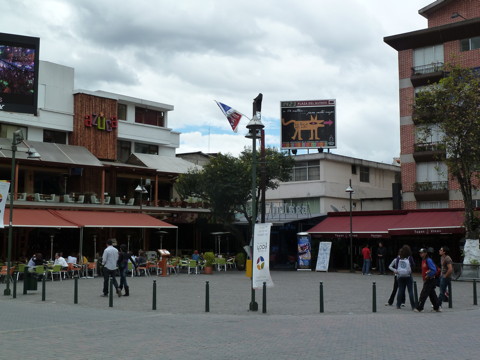 On the way back, we passed through
Plaza Foch which is the central party spot for the Mariscal
district. This place tends to get quite loud at night. Fortunately,
the Hostel Alcala was just far enough from the action that we could
hear a mix of several sources of loud music, but the combination
was not loud enough to keep us awake. We'll see tonight what the
noise level at the Hostel El Arupo is.
On the way back, we passed through
Plaza Foch which is the central party spot for the Mariscal
district. This place tends to get quite loud at night. Fortunately,
the Hostel Alcala was just far enough from the action that we could
hear a mix of several sources of loud music, but the combination
was not loud enough to keep us awake. We'll see tonight what the
noise level at the Hostel El Arupo is.
Sunday, July 25, 2010, Quito, Ecuador, about 1730 EST
(GMT-5)
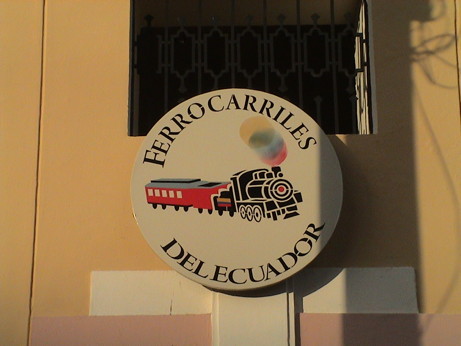 My how
plans can change in a day. We had given up on the train ride for
Saturday, but decided to try again on Sunday since we had nothing
else planned. We got up at 0600, caught a cab at about 0645 and
arrived at the station just before 0700 to get our tickets. The
station wasn't even open yet.
My how
plans can change in a day. We had given up on the train ride for
Saturday, but decided to try again on Sunday since we had nothing
else planned. We got up at 0600, caught a cab at about 0645 and
arrived at the station just before 0700 to get our tickets. The
station wasn't even open yet.
The train goes to Cotopaxi, but doesn't come back the same day
in time to see anything at the park. Those that go up usually take
a bus back. Instead, we went part way to a station south of Quito
called Machachi with a scheduled bus ride back at 1430. That trip
was $10/head.
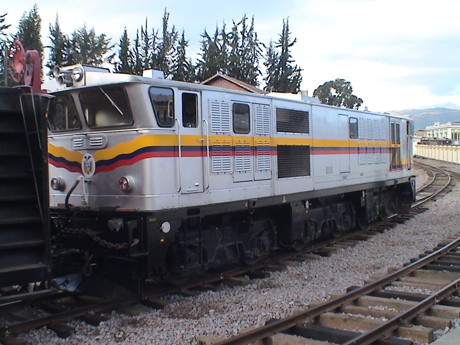 When we got
there, the crew was hooking this Alstrom B-B-B diesel loco to a
short train. I'll have more to say about this locomotive later.
When we got
there, the crew was hooking this Alstrom B-B-B diesel loco to a
short train. I'll have more to say about this locomotive later.
The Ecuadorian railway system is a 42" narrow gauge railroad
that used to go from near Guayaquil on the southern coast to a port
on the northern coast via Quito and a steep trip up through the
Andes. The road was very difficult to build, some say it was the
most difficult railroad in the world. Sometime in the 1960's,
several parts were washed out in a severe storm such that the
system failed. It wasn't making much money anyway and it could not
afford to rebuild itself so it was partly abandoned. There are
three operating sections, all operate as tourist roads now.
However, there is a plan to rebuild the whole system including the
chunk that we used as a road last year to get to the Loma Sandoval
site.
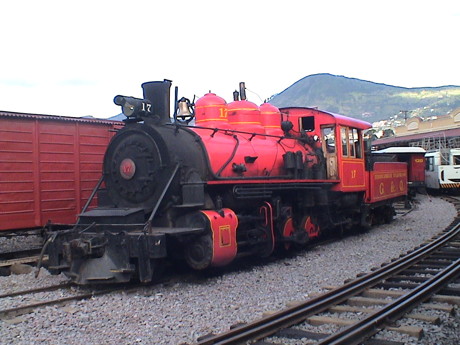 There is a
2-8-0 outside frame narrow gauge steam locomotive on a track at the
station, but it is currently non-operational. It needs some kind of
work and is expected to run again in a couple of years.... in
Ecuador time. This could mean anytime between two years and
never.
There is a
2-8-0 outside frame narrow gauge steam locomotive on a track at the
station, but it is currently non-operational. It needs some kind of
work and is expected to run again in a couple of years.... in
Ecuador time. This could mean anytime between two years and
never.
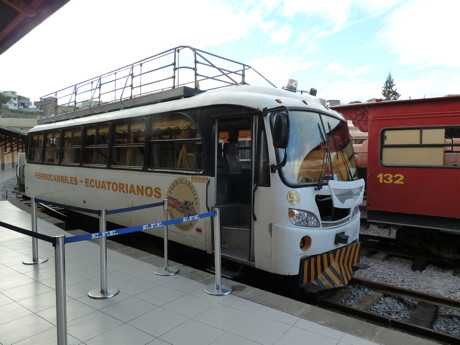 We thought
that we were going to take this fairly modern railbus. It left
promptly at 0800 without us on it. Our tickets were for the diesel
locomotive train, the loco and three cars.
We thought
that we were going to take this fairly modern railbus. It left
promptly at 0800 without us on it. Our tickets were for the diesel
locomotive train, the loco and three cars.
Our trip had one scheduled stop at Tambillo Station about an
hour out. The ride was slow and bumpy, much of it through the
southern and poorer parts of Quito, some of it street running. A
guy on a motor cycle played tag with the train, getting ahead of us
to guard grade crossing before we got there.
The scenery was not outstanding, mostly roughly built concrete
block buildings. There were some good views further south, but they
were from the other side of the train so I don't have any
reasonable pictures.
On some curves where I could see the loco, there appeared to be
a clear fluid, probably water, pouring out from the loco. I thought
that that was odd. We also stopped once in route while the crew
climbed all over the loco for a few minutes, then we proceeded to
the station.
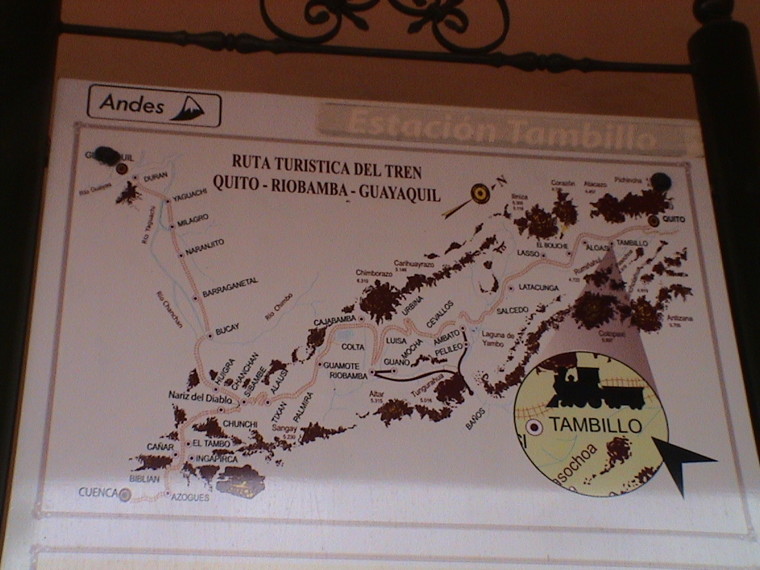 This is
a sign at Tambillo station showing the southern part of the route
from Quito back to Guayaquil (Duran). The line is broken in a
couple of places.
This is
a sign at Tambillo station showing the southern part of the route
from Quito back to Guayaquil (Duran). The line is broken in a
couple of places.
The crew got out a hose, backed the train down the track for a
hundred yards or so and poured water into some port on the top of
the loco. It was clear to me that there was some sort of a leak.
However, they might have thought that they had patched it.
We left Tambillo station and went south for only a mile or so
when the train stopped again. There was more commotion and then the
train returned running backwards to Tambillo Station. This time, we
were told that there would be a delay while a bus came to the
station to take us to the end of the trip at Machachi. We were
given the option of a voucher for another day, but we elected to
finish the trip.
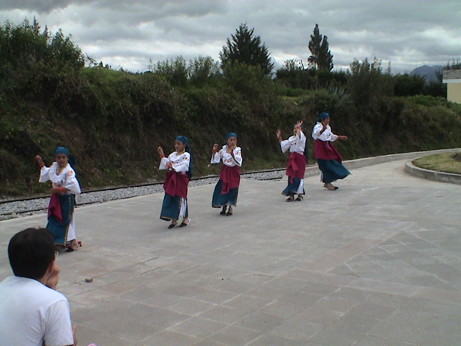 At the
Machachi Station, we were met by some dancers of various ages. They
performed some traditional dances and then we were given a sandwich
for lunch.
At the
Machachi Station, we were met by some dancers of various ages. They
performed some traditional dances and then we were given a sandwich
for lunch.
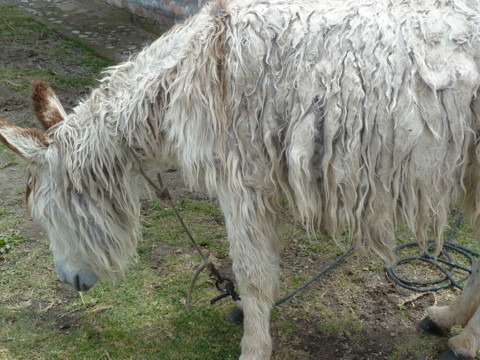 After lunch we had the
option of going on a complementary farm tour for a couple of hours
before our bus ride back to Quito. We had nothing better to do so
we took the tour. The "complementary" part meant that we had to buy
a ticket for $2/head. There wasn't much to see there besides some
well maintained grounds, a herb garden, and some farm animals. This
"farm" was clearly there to harvest money from tourists.
After lunch we had the
option of going on a complementary farm tour for a couple of hours
before our bus ride back to Quito. We had nothing better to do so
we took the tour. The "complementary" part meant that we had to buy
a ticket for $2/head. There wasn't much to see there besides some
well maintained grounds, a herb garden, and some farm animals. This
"farm" was clearly there to harvest money from tourists.
This burro is kind of odd. It is half llama, hence the long
shaggy coat.
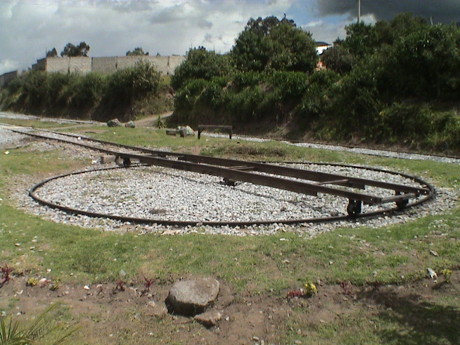 We
walked back the short distance to the station and I noticed that on
the other side was a small, manually operated turntable on a stub
siding. This guy is too light weight for the diesel, besides it is
double ended and doesn't need a turntable. It is too short for the
steamer and tender so it must be there to turn the railbuses.
We
walked back the short distance to the station and I noticed that on
the other side was a small, manually operated turntable on a stub
siding. This guy is too light weight for the diesel, besides it is
double ended and doesn't need a turntable. It is too short for the
steamer and tender so it must be there to turn the railbuses.
We got on another bus at 1400 and rode about an hour back to
Quito along the Pan American Highway, a good four lane road. From
there we got on the MetroQ trolly bus. The trolly busses run the
full length of Quito for a fare of $0.35. Since we didn't get on at
the end of the line, our fare was $0.25, quite a bit cheaper than
the cab which cost $6. However it doesn't go directly to the
Mariscal district. There is a Mariscal stop where we got off. I
recognized the streets there and we walked about a mile back to our
hostel in a light rain.
Monday, July 26, 2010, Hacienda Guachala, Ecuador, about 1900
EST (GMT-5)
Today was a long day. We slept to about 0830 and got breakfast
in the hostel. It was pretty standard, eggs, toast, fruit and
juice. Then we caught a cab to the airport to get our rental car.
The one that Sandy first signed up for was pretty small and it was
not suitable for dirt roads so we got a slightly larger 4WD car. I
think that the brand is Vitara, a GM product. It is a basic car
without A/C (not needed here), nor power anything including the
motor. It is a 5 speed with a 2 speed transfer case and manual
hubs.
We drove back to the hostel and parked it for about an hour in
their gated driveway while we attempted to pack it. Eric lugged his
gear from the Jardin del Sol a couple of blocks away and we BARELY
got it all in. It was a very tight fit.
Then we drove up to the IGM so Eric could get has aerial photos.
They had said that the photos would not be available until 1500 and
they meant it. We sat in the parking lot of the IGM for 3 hours and
THEN they released the photos.
It was 1530 by the time that we left the IGM. We used Sandy's
iPad 3G to navigate out of Quito. We don't have 3G data here but we
had cached the maps needed while were in the hostel using their
WiFi. The iPad does a credible job of keeping the recently viewed
maps in memory somewhere so that we could recall them even when not
in contact with the internet.
After we left Quito, we found that some parts of the Pan
American Highway maps in Google (or wherever the iPad Maps apps
gets them) were pretty inaccurate. GPS had us driving cross country
in spots but at least it was within a few hundred yards to the
mapped road. Using GPS for a long time really whacks the battery in
the iPad, it will run for 10 hours doing normal stuff but under 3
with the GPS running continuously. However, I brought an inverter
so that we could run it's charger from the cigarette lighter
socket. That worked fine, it ended up with more charge than it
started with.
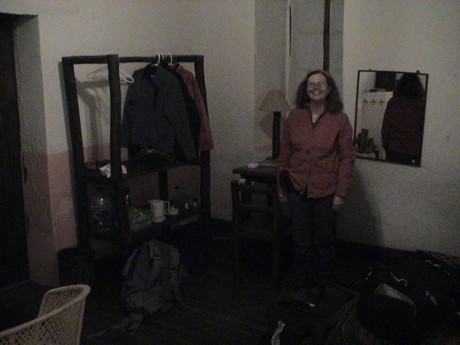 We did get to the
Hacienda Guachala at about 1700 but there was nobody around. It
took some wandering around the grounds that could get us keys.
These photos are pretty dark because my camcorder doesn't have a
flash, I'll get some better ones in the coming days. We are in a
much larger room this year. Eric is in the room we had last
year.
We did get to the
Hacienda Guachala at about 1700 but there was nobody around. It
took some wandering around the grounds that could get us keys.
These photos are pretty dark because my camcorder doesn't have a
flash, I'll get some better ones in the coming days. We are in a
much larger room this year. Eric is in the room we had last
year.
Sandy is standing near the "closet" and the desk that I am using
now to write this page. We are using the lower shelf as a pantry
for what little food we brought with us. We had a sumptuous dinner
of peanut butter sandwiches, snack crackers and water.
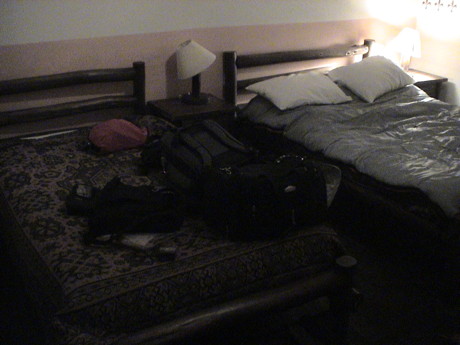 The room has a queen
and a double bed. We brought one sleeping bag this year instead of
two. It is unfolded on the queen bed for warmth.
The room has a queen
and a double bed. We brought one sleeping bag this year instead of
two. It is unfolded on the queen bed for warmth.
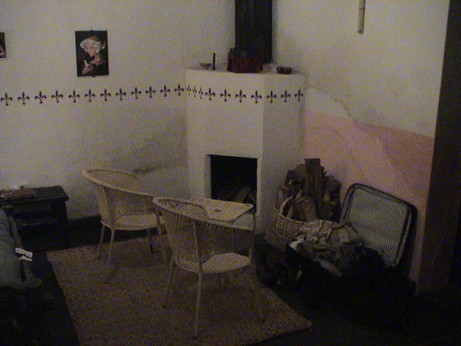 The room has a
fireplace and there is wood and kindling provided. The Hacienda is
generally a colder and more windy place that Quito. The hostels in
Quito didn't even have heat because it just isn't needed.
The room has a
fireplace and there is wood and kindling provided. The Hacienda is
generally a colder and more windy place that Quito. The hostels in
Quito didn't even have heat because it just isn't needed.
I moved the little table that was intended to support a suitcase
from where my suitcase is now to the other side of the fireplace
near an electrical outlet. That will be our charging station for
random stuff. I'll charge my computer from an outlet near the
desk.
The Hacienda has internet, at least they did last year, but we
didn't ask the woman that checked us in to create an account for
us. We'll do that tomorrow. I'll have to walk across the plaza to
the library to reach the wireless internet. Our internet
connectivity will be intermittent at best, we'll get on maybe once
or twice a day so updates to this page and responses to email will
have about a day or two of latency.
Besides ourselves and Eric, nobody from the project has arrived.
Amber won't make it at all. Sam is in country but probably won't be
here for a few days. I don't know who else might show up.
Our tasks for tomorrow are to find and start digging through the
project artifact archives. They got moved from the place that they
were stored after the project closed last year. Then we and Eric
need to go into Cayambe to stock up on supplies. We need to sign up
for some internet time.
Tuesday, July 27, 2010, Hacienda Guachala, Ecuador, about 2000
EST (GMT-5)
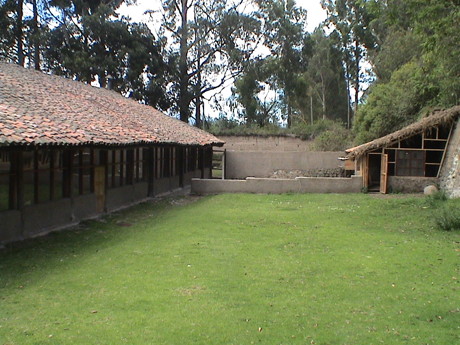 While we were
waiting for the key to the store room that held the project
archives, Cristobal took us on a short tour of the changes that had
been made since last year. What used to be our lab has been turned
into a row of schoolrooms. The horse paddock has been allowed to
fill with grass and the rabbit hutches and chicken coops are no
longer occupied. The large room that we had used for a lecture hall
was filled with furniture destined for the school.
While we were
waiting for the key to the store room that held the project
archives, Cristobal took us on a short tour of the changes that had
been made since last year. What used to be our lab has been turned
into a row of schoolrooms. The horse paddock has been allowed to
fill with grass and the rabbit hutches and chicken coops are no
longer occupied. The large room that we had used for a lecture hall
was filled with furniture destined for the school.
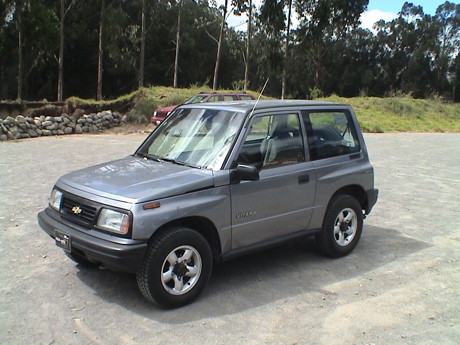 We left the
Hacienda in our rental car at about 1030 headed for Cayambe to buy
supplies at the Gran Aki market. That was the easy part. We also
needed some other stuff that wasn't all found.
We left the
Hacienda in our rental car at about 1030 headed for Cayambe to buy
supplies at the Gran Aki market. That was the easy part. We also
needed some other stuff that wasn't all found.
We needed the key to the store room duplicated, Sandy wanted to
find a geologic hammer or something similar and I wanted to find a
steering wheel lock for the rental car. The key duplicator was a 6
foot wide stall in the market next to the Gran Aki market but we
walked all around the area trying to find it. We also visited
almost every hardware store in Cayambe looking for the right kind
of hammer. We settled for a 2 lb hammer and a cold chisel. We
believe that we hit every car parts store in Cayambe and didn't
find the lock. However, at an auto alarm place, the guy said that
he would get one by Friday. Since the car will be at the Hacienda
for much of that time, we aren't too concerned as this place is
pretty secure. They haven't had a crime problem here that we know
about.
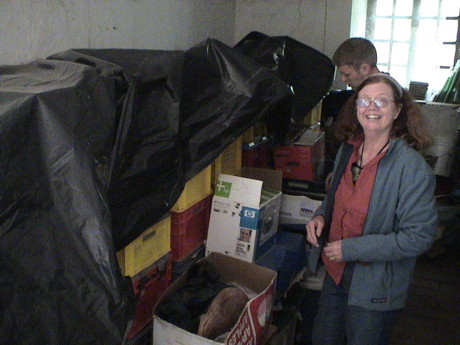 After we got back at about 1400, we had a lunch of sandwiches and
then got to work. Eric and I started going through each of the
storage crates, some were very heavy, looking for obsidian for
Sandy and Eric's surface collection samples from years past. We
found some of it anyway. We set up in the church to allow Sandy to
examine and catalog the samples. She quit when it got dark as there
is good sunlight in the church but no artificial light.
After we got back at about 1400, we had a lunch of sandwiches and
then got to work. Eric and I started going through each of the
storage crates, some were very heavy, looking for obsidian for
Sandy and Eric's surface collection samples from years past. We
found some of it anyway. We set up in the church to allow Sandy to
examine and catalog the samples. She quit when it got dark as there
is good sunlight in the church but no artificial light.
We hauled three crates down initially for Sandy, Eric took one.
We have about half a dozen more segregated in the store room. As we
go through one the ones that we have moved already, we'll move more
of them down.
That was enough work for the day, my back told me that I
shouldn't be lifting more crates for the day. I went back to the
room to update this page and rest.
After a short rest, I tested two HP scanner/printers that we
found in the lab. An old PSC 1209 had no print cartridges. A newer
F380 did. However, neither of them worked with my old PowerBook,
the HP drivers were not there. Sandy's newer MacBook uses Snow
Leopard and it has a MUCH better set of HP drivers baked in. Both
of them worked with Sandy's computer so that she can scan to her
heart's content.
At 1830, the three of us went over to the dining room for
dinner. We ordered off the menu and had a good mustard and lemon
chicken for about $7 each. By 2000, we were back in the room with a
nice fire going. I didn't have enough of the right kindling last
night and the fire fizzled so this afternoon, I scouted the grounds
for more sticks and twigs, the necessary factor in getting enough
initial heat to light the firewood provided.
We tried to get an internet password from the office, but the
tickets that have the passwords on them were not there. We'll have
to wait for tomorrow to upload our pages. Sandy's blog can be found
at SandySchreyer.com.
Later in the trip, we plan to visit some of the obsidian flows
and take some fresh samples from the flows to calibrate the
measurement for those sites anyway. This probably won't happen
until next week. In the meantime, we'll be going through the
samples stored here at the Hacienda to determine which will be
taken to the US for X-ray florescence and laser ablation
analysis.
Wednesday, July 28, 2010, Hacienda Guachala, Ecuador, about
1300 EST (GMT-5)
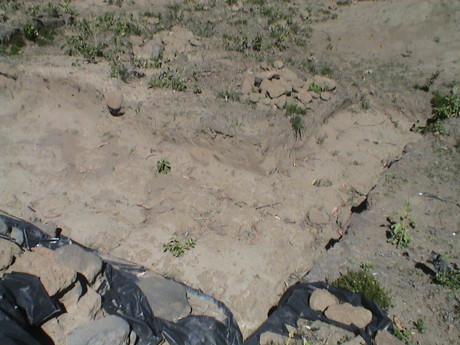 Since Sandy
needed some information from Sam before she could efficiently
continue sorting her samples and he was supposed to arrive around
noon, we elected to spend some time on Molina Loma, a site on a
hill above the Hacienda, where we were doing excavation last year.
This is what unit 27 looks like now after a year of exposure to the
weather. I thought it was going to be protected and filled, but it
appears that that did not happen.
Since Sandy
needed some information from Sam before she could efficiently
continue sorting her samples and he was supposed to arrive around
noon, we elected to spend some time on Molina Loma, a site on a
hill above the Hacienda, where we were doing excavation last year.
This is what unit 27 looks like now after a year of exposure to the
weather. I thought it was going to be protected and filled, but it
appears that that did not happen.
The weather on Molina Loma was perfect. It was sunny, cool and
breezy. The breeze turned to wind at times, but in any event it
kept the bugs away. We got rained on intermittently out of a clear
blue sky. The nearest clouds were more than a mile away so that the
rain drops were probably being blown in by the wind. There wasn't
enough to get us wet though.
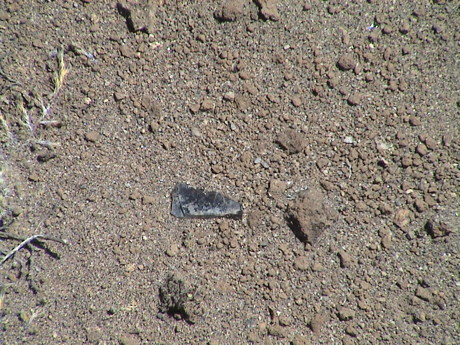 Our plan was to do a
surface survey of obsidian samples on the back side of the hill.
These would have been washed down from the hilltop where the Inka
site was. The particular area that we picked was not forested and
mostly exposed bedrock and generally free of leaf litter so that a
surface survey would be easier. We found about a dozen pieces
total, mostly like this one just sitting fully exposed on a sand
filled depression where it washed to and stayed. These pieces are
extremely easy to see because the contrast so completely with the
surrounding soil.
Our plan was to do a
surface survey of obsidian samples on the back side of the hill.
These would have been washed down from the hilltop where the Inka
site was. The particular area that we picked was not forested and
mostly exposed bedrock and generally free of leaf litter so that a
surface survey would be easier. We found about a dozen pieces
total, mostly like this one just sitting fully exposed on a sand
filled depression where it washed to and stayed. These pieces are
extremely easy to see because the contrast so completely with the
surrounding soil.
The last two pieces that we saw were a complete surprise. They
were smack dab in the middle of the trail leading up to the site.
Over the course of two seasons, many hundreds of eyeballs scanned
this trail yet they had not been picked up. One was a scraper that
might have washed onto the trail. The other was a larger chunk that
was fully embedded in the middle of the trail. Perhaps some soil
covering this piece had washed away during the last year.
Sandy is going to do lab work this afternoon, I am going to
snooze.
Thursday, July 29, 2010, Hacienda Guachala, Ecuador, about 1600
EST (GMT-5)
I didn't end up snoozing yesterday afternoon. Instead I
schlepped stuff to and from our room, the church and the store
room.
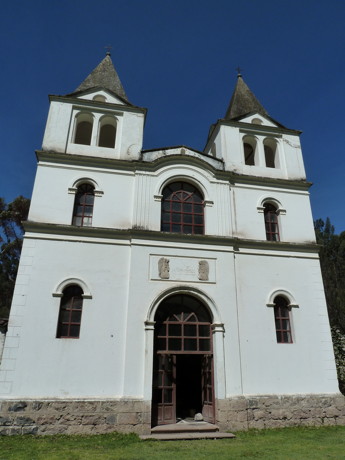 Since we didn't
have a lab, we set up in the church, built in 1938. The church
isn't secure, there are three doors without locks, but at least it
has good light and the roof is mostly intact. There is some
sunlight shining through in places, but I don't know how badly it
leaks. Next time we get some rain here, I'll go in there and take a
look.
Since we didn't
have a lab, we set up in the church, built in 1938. The church
isn't secure, there are three doors without locks, but at least it
has good light and the roof is mostly intact. There is some
sunlight shining through in places, but I don't know how badly it
leaks. Next time we get some rain here, I'll go in there and take a
look.
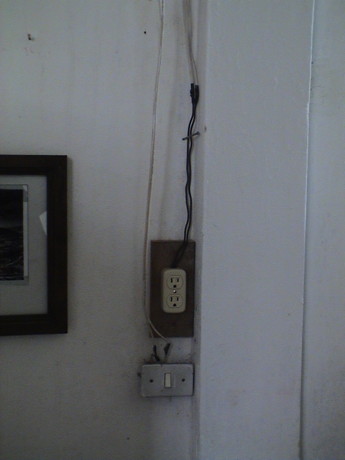 I also
investigated the remnants of wiring in the church. When they ripped
out the dry rotted ceiling last year, the also ripped out the power
wires to the hanging lamps that ran down the center of the church.
The wiring was simply bundled up in the choir bay. There is a light
switch and an ungrounded outlet at the rear of the church. The
wiring for ALL of this stuff is not even close to US building
codes, but it seems to be normal for Ecuador.
I also
investigated the remnants of wiring in the church. When they ripped
out the dry rotted ceiling last year, the also ripped out the power
wires to the hanging lamps that ran down the center of the church.
The wiring was simply bundled up in the choir bay. There is a light
switch and an ungrounded outlet at the rear of the church. The
wiring for ALL of this stuff is not even close to US building
codes, but it seems to be normal for Ecuador.
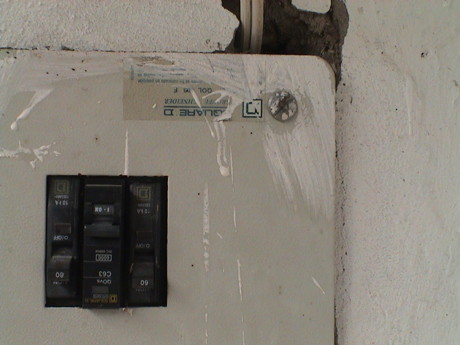 There is
a heavy gauge pair in the choir bay that snakes its way outside via
some chipped out adobe next to a window frame in the south bell
tower, out across the peak of the room just east of the bell
towers, down the other side and across a wall that connects the
church to the row of rooms that used to be the stable. There it
dives into a circuit breaker box. There are three circuit breakers,
all appear to be ON.
There is
a heavy gauge pair in the choir bay that snakes its way outside via
some chipped out adobe next to a window frame in the south bell
tower, out across the peak of the room just east of the bell
towers, down the other side and across a wall that connects the
church to the row of rooms that used to be the stable. There it
dives into a circuit breaker box. There are three circuit breakers,
all appear to be ON.
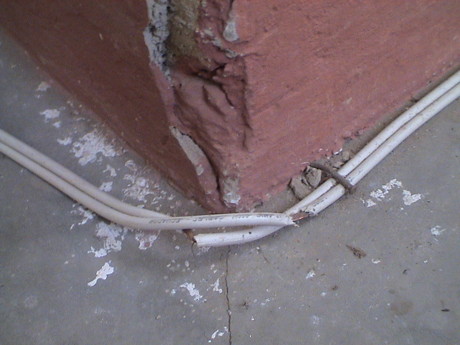 There
could be power in the church, but there is some damage to the
wiring in the choir bay that needs to be repaired. It appears that
there may still be connectivity even with the damaged insulation.
Since all the breakers seem to be on the exposed wiring may be hot.
I dragged a table lamp from our room over to the church and plugged
it in and the circuit is indeed hot. The light switch is in the on
position so that the cut wiring bundle in the choir bay is probably
hot at the cut end too. I don't feel like messing with this and
getting fried in Ecuador. Some Ecuadorian electrician can patch
this back to their standards if we really need power in there.
There
could be power in the church, but there is some damage to the
wiring in the choir bay that needs to be repaired. It appears that
there may still be connectivity even with the damaged insulation.
Since all the breakers seem to be on the exposed wiring may be hot.
I dragged a table lamp from our room over to the church and plugged
it in and the circuit is indeed hot. The light switch is in the on
position so that the cut wiring bundle in the choir bay is probably
hot at the cut end too. I don't feel like messing with this and
getting fried in Ecuador. Some Ecuadorian electrician can patch
this back to their standards if we really need power in there.
The day before yesterday, we got an internet code but it didn't
work, we could not log in. The office manager managed to connect
using my computer and her office code so that we know that our code
is bad. Later, we got another one and that worked, hence the web
page upload yesterday. Gmail IMAP is not working for incoming and
outgoing and girr.org is not working for outgoing so I may have to
send mail via the webmail interface for girr.org or gmail unless
one of them starts to work via the regular Macintosh Mail tool.
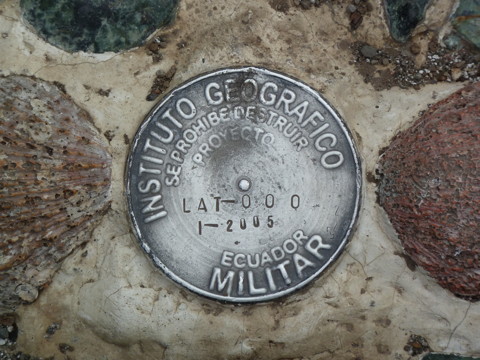 While Sandy was in
the church sorting through obsidian samples, I took the car up to
Mitad del Mundo (the middle of the world) where there is a monument
and marker for the equator. This marker was placed by the the IGM
in 2005 using geodesic GPS. It's latitude is 0.000. The longitude
is 78° 10 min 30 sec west. Sandy's GPS enabled camera nailed
the longitude, but it was off by 0.00003 deg in latitude. I also
got readings on the iPad, it read 0.00003654° latitude and
78.17506481° longitude. The elevation was 2728 meters which was
probably about 75 meters high. I was also recording my position
continually using Sandy's Holux GPS tracker module, but it doesn't
report it's logged data on the device. Sandy needs to download the
data file to see what it recorded. I also walked the equator line
at the monument, we'll see how well it's latitude points track.
While Sandy was in
the church sorting through obsidian samples, I took the car up to
Mitad del Mundo (the middle of the world) where there is a monument
and marker for the equator. This marker was placed by the the IGM
in 2005 using geodesic GPS. It's latitude is 0.000. The longitude
is 78° 10 min 30 sec west. Sandy's GPS enabled camera nailed
the longitude, but it was off by 0.00003 deg in latitude. I also
got readings on the iPad, it read 0.00003654° latitude and
78.17506481° longitude. The elevation was 2728 meters which was
probably about 75 meters high. I was also recording my position
continually using Sandy's Holux GPS tracker module, but it doesn't
report it's logged data on the device. Sandy needs to download the
data file to see what it recorded. I also walked the equator line
at the monument, we'll see how well it's latitude points track.
At lunch, we met with Sam, Anna, Gaby, Cristobal and Dennis.
Gaby and Cristobal marked Sandy's topo map with the obsidian source
that they ran across while camping. There are no roads to get there
and even if we hiked in there, it would be after the time that we
need to tell the Ecuadorian government what we want to bring out.
We had a long discussion with Dennis about how obsidian might have
been traded during the period when the Inka was consolidating their
conquest of northern Ecuador. We met with Sam to go through the
status of the store room. There is a box somewhere of reports that
he had printed last year, but I could not find them. I expect that
they are not here. Sandy spent much of the afternoon sorting
through obsidian samples collected in the past to determine which
ones would be the most likely to be of help in her study. We
basically have to declare what we want to bring out by Monday to
even hope to get approval by the government.
We've settled down to a meal plan. We get breakfast in our room
consisting of fruit, bread and juice that we bought in Cayambe.
Lunch is sandwiches from the same source. We get dinner in the
dining room by ordering off the menu. The food prepared here has
been uniformly good and of sufficient quantity. Dinners are costing
us $7 to $10 a head with beverage.
Friday, July 30, 2010, Hacienda Guachala, Ecuador, about 1730
EST (GMT-5)
The logistics for getting approval from the Ecuadorian
government for removal of the samples from Ecuador are going to be
tight. Sandy has to get all her samples ready by Sunday afternoon.
We won't be able to do any more collections from sites or obsidian
sources. She'll have to make do with what she can get from the PAP
archives.
On Monday, we will go back to Quito and meet Sam there
somewhere. From there, we'll go to the INPC, the government entity
that deals with antiquities, and hopefully get permission to remove
the samples that we culled from the PAP archives. This can take
some time and we can only hope that the government agency will
provide approval in time. If approval does not come through, the
samples will stay here and Sandy will have to make do with other
legally exported samples that have already been delivered to Cal
State Fullerton on her behalf.
This morning was filled with errands in Cayambe. The steering
wheel lock was actually delivered to the auto alarm shop and we
paid $18 for it. We dropped our laundry at a lavadoria (a laundry
shop). Then we stocked up on supplies at the Gran Aki and returned
to the Hacienda.
Just after lunch it started to rain so I went over to the church
to see how badly the roof leaks It didn't rain hard enough to tell
if the light shining through the roof will result in serious
leaks.
In any event, we moved out of the church for the weekend. It
will be crazy as there is supposed to be a motocross event here
this weekend and the church is not secure. There will be lots of
curious people wandering around and we don't want the project stuff
messed with. Eric didn't get his room reserved so he has to move to
Cayambe for the weekend, he may stay there or move back next week.
We stashed all the stuff that is still in work in our room so Sandy
can continue to work over the weekend. Eric has one box of stuff,
but he will stash it here before he leaves tomorrow morning.
Saturday, July 31, 2010, Hacienda Guachala, Ecuador, about 2230
EST (GMT-5)
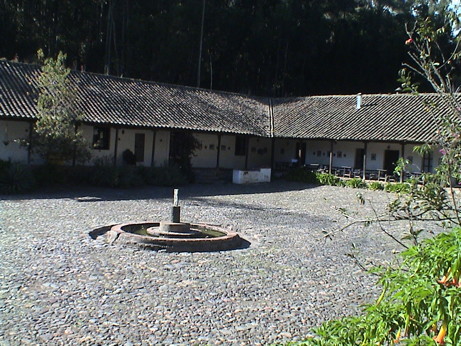 I got up a little
earlier than normal, 0800, today to go on a hike with Eric and
Dennis. I didn't know when they were planing to leave, but I could
have slept in for another hour. However, it was bright, sunny and
warm outside. This is the view of the Hacienda plaza from just
outside our room. Straight back in the middle of the photo is the
library and internet room. To the right is a row of tables that is
used by the Hacienda restaurant for breakfast and lunch. Dinner is
served indoors when it is usually too cool outside.
I got up a little
earlier than normal, 0800, today to go on a hike with Eric and
Dennis. I didn't know when they were planing to leave, but I could
have slept in for another hour. However, it was bright, sunny and
warm outside. This is the view of the Hacienda plaza from just
outside our room. Straight back in the middle of the photo is the
library and internet room. To the right is a row of tables that is
used by the Hacienda restaurant for breakfast and lunch. Dinner is
served indoors when it is usually too cool outside.
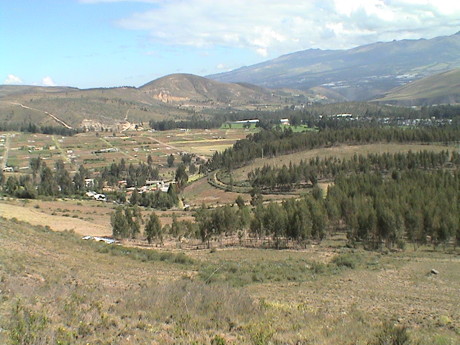 The hike was supposed to
go to two places but Dennis and I were both tired so we passed on
the 2nd destination. One of them was the site of a possible Inka
"watchtower" way up on the hillside on the largest hill behind the
Hacienda. When I took this photo, we hadn't located the structure
yet, it was another 50 meters or so up the very steep hill.
However, from here, there is a good view. The bare region on the
hill below is where Sandy and I surveyed a few days ago. That hill
is Molinoloma, the Inka site we helped excavate is just inside the
tree line on the top of the hill. The Hacienda is just on the other
side of the hill. The settlement to the left is the town of Buena
Esperanza.
The hike was supposed to
go to two places but Dennis and I were both tired so we passed on
the 2nd destination. One of them was the site of a possible Inka
"watchtower" way up on the hillside on the largest hill behind the
Hacienda. When I took this photo, we hadn't located the structure
yet, it was another 50 meters or so up the very steep hill.
However, from here, there is a good view. The bare region on the
hill below is where Sandy and I surveyed a few days ago. That hill
is Molinoloma, the Inka site we helped excavate is just inside the
tree line on the top of the hill. The Hacienda is just on the other
side of the hill. The settlement to the left is the town of Buena
Esperanza.
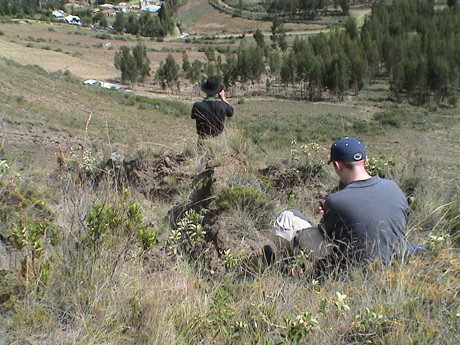 This photo is taken from
the "watchtower" which is not much more than a couple of walls made
of piled up stone and mud. Eric is in the foreground, Dennis is
down the hill a little. However, there seemed to be a pathway that
ran right through this structure, whatever it really was.
This photo is taken from
the "watchtower" which is not much more than a couple of walls made
of piled up stone and mud. Eric is in the foreground, Dennis is
down the hill a little. However, there seemed to be a pathway that
ran right through this structure, whatever it really was.
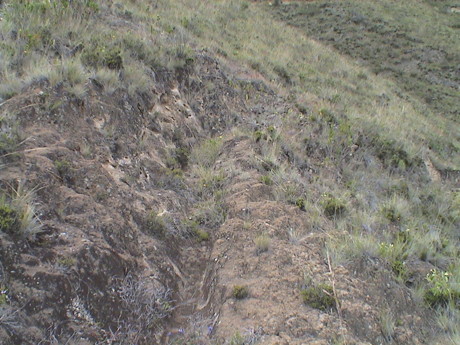 We followed the pathways
up the hill for some distance. They had been clearly used recently,
probably by grazing animals, as they were mostly clear of
vegetation and the rocks were rounded and eroded. At first, I
thought that these features might be slip fractures but slip
fractures do not zig-zag. The paths had many zig-zags continuing up
the hill further than we went. These could have been part of an
Inka "road."
We followed the pathways
up the hill for some distance. They had been clearly used recently,
probably by grazing animals, as they were mostly clear of
vegetation and the rocks were rounded and eroded. At first, I
thought that these features might be slip fractures but slip
fractures do not zig-zag. The paths had many zig-zags continuing up
the hill further than we went. These could have been part of an
Inka "road."
As we walked back to the Hacienda from Molinoloma, the soccer
field and adjacent pasture had been marked off with red tape. A
motocross course was being set up. The course went through some
tight turns on the flat grassy area and then headed up the hill for
a run around Molinoloma. Apparently, the race will be tomorrow, 50
laps, and will run for about 3 hours.
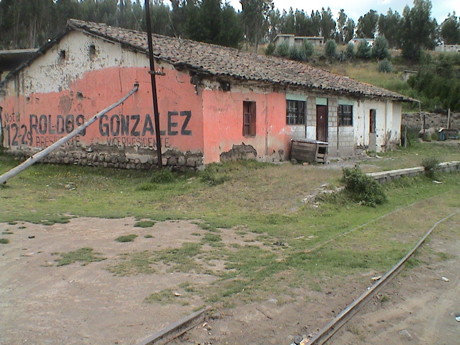 After
returning to the Hacienda over Molinoloma, I ferried Eric into
Cayambe so that he could check into his hostel. We also picked up
our laundry. On the way back, I took a picture of the railroad
station at the junction of the Cangahua road and the Pan American
highway. Last year, we used to roadbed at the right as the way to
Loma Sandoval. If the Ecuadorian railroad wants to rebuild this
line, they have some work to do.
After
returning to the Hacienda over Molinoloma, I ferried Eric into
Cayambe so that he could check into his hostel. We also picked up
our laundry. On the way back, I took a picture of the railroad
station at the junction of the Cangahua road and the Pan American
highway. Last year, we used to roadbed at the right as the way to
Loma Sandoval. If the Ecuadorian railroad wants to rebuild this
line, they have some work to do.
We got back to the Hacienda again, made some lunch and then it
started to rain. As usual, the rain didn't last very long and the
ground dries out in just a few minutes. The weather in the Andean
highlands is mostly cool and dry. The temperatures hardly change
over the year. There is only a dry season (now) and a wet season.
There are few bugs, but there are some flies that bite. I've had
just two bites since I've been here and they itched for only a
little while. This is in striking contrast to the weather in
Belize.
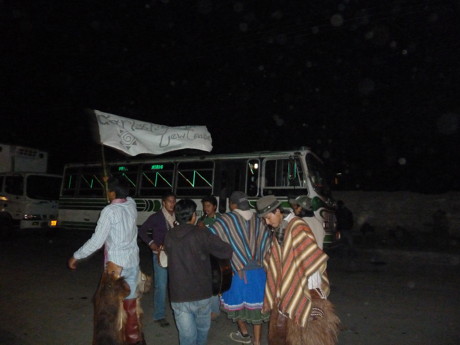 After we
returned to the room from dinner, we could hear a party going on in
the little town of Buena Esperanza near the Hacienda. We walked up
there and found a small group of young men dancing in the road and
generally blocking what little traffic there was. These guys were
pretty drunk already. Buena Esperanza was in the midst of their
festival. The group invited us to dance with then as we slowly made
our way up the street and onto a side street where the big party
was. We were offered whisky, Sandy accepted but I could not as I am
not allowed alcohol.
After we
returned to the room from dinner, we could hear a party going on in
the little town of Buena Esperanza near the Hacienda. We walked up
there and found a small group of young men dancing in the road and
generally blocking what little traffic there was. These guys were
pretty drunk already. Buena Esperanza was in the midst of their
festival. The group invited us to dance with then as we slowly made
our way up the street and onto a side street where the big party
was. We were offered whisky, Sandy accepted but I could not as I am
not allowed alcohol.
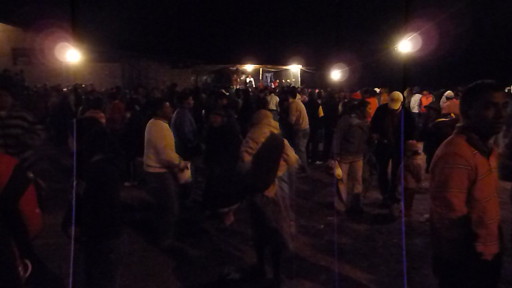 The lighting is
not so good, but there was a big party going on with very loud
music and lots of dancing at a spot a few hundred yard off the
highway. There had to be 500 people there, most of them fully or
partially drunk. Sandy was offered chicha (a slightly alcoholic hot
drink made from corn) by many folks. I had to explain that I could
not drink due to a medical problem and they understood. It is
normally considered an insult to refuse chicha. We hung around
until Sandy got a little tipsy and then we wandered home.
The lighting is
not so good, but there was a big party going on with very loud
music and lots of dancing at a spot a few hundred yard off the
highway. There had to be 500 people there, most of them fully or
partially drunk. Sandy was offered chicha (a slightly alcoholic hot
drink made from corn) by many folks. I had to explain that I could
not drink due to a medical problem and they understood. It is
normally considered an insult to refuse chicha. We hung around
until Sandy got a little tipsy and then we wandered home.
Sunday, August 1, 2010, Hacienda Guachala, Ecuador, about 2100
EST (GMT-5)
When I woke up this morning, my right heel was really sore.
There was a bump below my ankle and it felt like I had strained or
sprained something. I also had a splinter from handling the
firewood last night. The splinter was fairly easy to deal with, but
my ankle was not. I was hobbling around all day. The more I moved,
the less pain I felt, but as soon as I rested it, it started to
hurt again. We'll see how long this takes to resolve.
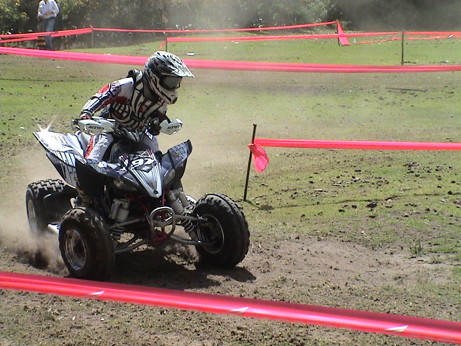 Today is race day. A motocross event has been scheduled at the
Hacienda. Most of the teams came in this morning and set up the pit
area in the pasture south of the Hacienda. The soccer field that we
surveyed with ground penetrating radar last year is an obstacle
course. The first race is quadratrack riders. The main event will
run for 50 laps, about 3 hours.
Today is race day. A motocross event has been scheduled at the
Hacienda. Most of the teams came in this morning and set up the pit
area in the pasture south of the Hacienda. The soccer field that we
surveyed with ground penetrating radar last year is an obstacle
course. The first race is quadratrack riders. The main event will
run for 50 laps, about 3 hours.
From the soccer field, the course goes up the hill on the road
that we used to walk to Molinoloma. Then it runs counterclockwise
around the hill and comes down on a path just behind the Hacienda
pool. It then turns across the pasture along the back and then onto
the soccer field again.
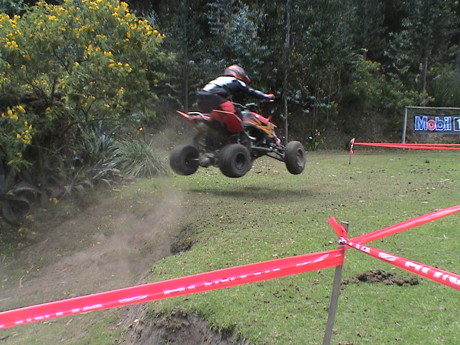 At the transition from the pasture to the soccer field, there is a
small jump. Some of the riders were getting air at that spot, most
did not.
At the transition from the pasture to the soccer field, there is a
small jump. Some of the riders were getting air at that spot, most
did not.
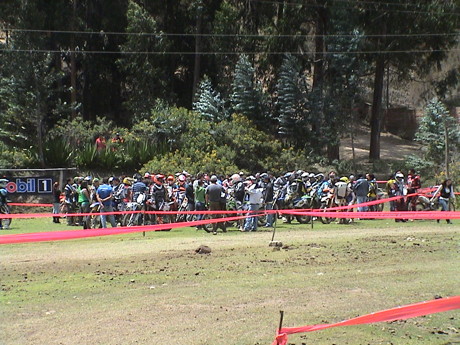 At about 1130
the motorcycle riders took a couple of practice laps and lined up
for the start. There has to be more than 50 of them.
At about 1130
the motorcycle riders took a couple of practice laps and lined up
for the start. There has to be more than 50 of them.
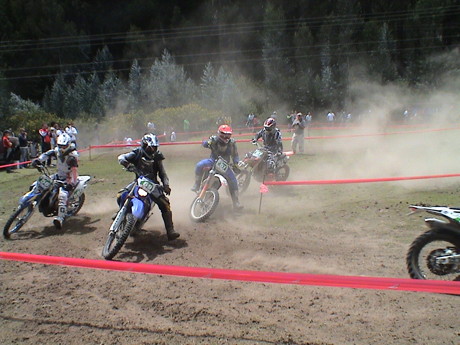 The race was
apparently started in classes, I took this picture at the start
before the dust got so bad that photography was impractical.
Eventually the field spread out enough so that the dust often had a
chance to blow away before the next rider came through.
The race was
apparently started in classes, I took this picture at the start
before the dust got so bad that photography was impractical.
Eventually the field spread out enough so that the dust often had a
chance to blow away before the next rider came through.
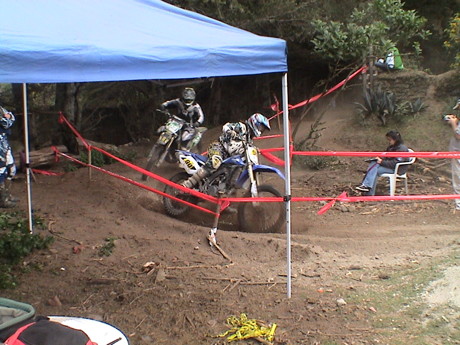 This is where
the riders come down the hill to start the run on the flat section.
Most of them were going pretty slowly here so I could get a clear
shot, I expected less caution.
This is where
the riders come down the hill to start the run on the flat section.
Most of them were going pretty slowly here so I could get a clear
shot, I expected less caution.
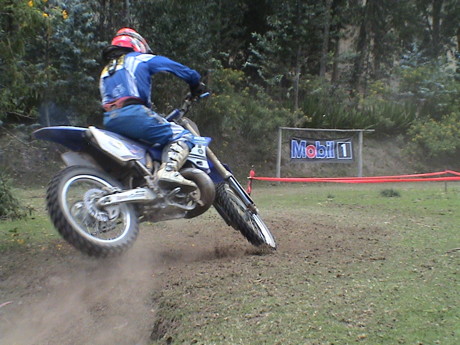 At the jump,
most riders didn't get any air at all. A few did, but not as much
as some of the quadratrack riders did.
At the jump,
most riders didn't get any air at all. A few did, but not as much
as some of the quadratrack riders did.
The race is still going on. Apparently, every five laps or so,
the teams switch riders to give the other team member a rest.
They'll come down the hill and turn into the pit area and do a
quick swap and gas up if necessary.
By 1400, the race was over and noise of the motorcycles stopped.
The riders got a little cleaned up and came over to the plaza for a
buffet lunch. It looked pretty good, but I had already had lunch.
Then the winners were announced and the awards handed out. Pretty
much everybody had already loaded their motorcycles onto their
trucks and when the festivities were done, the teams filtered out.
Peace and quiet returned to the plaza. The motocross course was a
disaster. Where there used to be a soccer field, the grass was
substantially gone and deep ruts marked the turns. The trail down
the hill was simply deep dust. It'll take a while for the damage to
be repaired.
This place closes up tight on Sundays but we took a chance and
drove into Cayambe looking for a restaurant, no dice, they were
closed. We drove back to the Hacienda and had dinner here. We were
the only three folks at dinner. The Hacienda has emptied out
again.
My ankle was not any better by bedtime, it might have been
worse. At least it isn't black and blue so that whatever injury
that I sustained isn't really bad. It will, however, constrain my
movements. I was getting around all day, but not quickly.
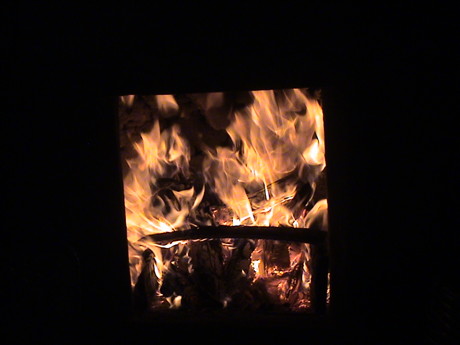 One thing
we look forward too each night is a fire in our fireplace. It not
only heats the room, but it provides some "atmosphere." Last year I
sometimes had problems getting a fire going, or if it sustained
itself, it didn't make a lot of heat. This year, I've figured it
out. This fire was so hot that I had to sit back about 10 ft or get
roasted. The secret is to collect sticks up to a half inch in
diameter. These are all over the grounds and are usually pretty
dry. They ignite easily and make enough heat to dry out the
somewhat wet firewood such that it will start to burn before the
kindling goes out. The second secret is to use a couple of larger
boards along the sides to support a log cabin style stack above the
kindling so that the fire can breath properly. This also leaves a
volume at the bottom where the hot coals can gather to make a layer
of glowing coals that will both emit heat into the room and heat
the new wood enough so that it can dry out too.
One thing
we look forward too each night is a fire in our fireplace. It not
only heats the room, but it provides some "atmosphere." Last year I
sometimes had problems getting a fire going, or if it sustained
itself, it didn't make a lot of heat. This year, I've figured it
out. This fire was so hot that I had to sit back about 10 ft or get
roasted. The secret is to collect sticks up to a half inch in
diameter. These are all over the grounds and are usually pretty
dry. They ignite easily and make enough heat to dry out the
somewhat wet firewood such that it will start to burn before the
kindling goes out. The second secret is to use a couple of larger
boards along the sides to support a log cabin style stack above the
kindling so that the fire can breath properly. This also leaves a
volume at the bottom where the hot coals can gather to make a layer
of glowing coals that will both emit heat into the room and heat
the new wood enough so that it can dry out too.
Monday, August 2, 2010, Hacienda Guachala, Ecuador, about 1600
EST (GMT-5)
My ankle wasn't any better this morning but I can get around,
albeit slowly.
We got an email from Sam describing what we need to do to
hopefully get the obsidian samples out of the country. Sandy had
the data ready and she was able to modify the sample letter that
Sam provided in an appropriate fashion, but the printer that we
had, the only one with print cartridges in it, printed one page and
then declared a failure with the black cartridge. It feels empty
anyway.
Sam wanted to meet us at 0900 tomorrow, but due to Quito traffic
restrictions, our car is not allowed into the city until 0930.
We'll enter the city at 0930 and meet Sam before 1000 at the INCP
with the samples and the necessary documents.
After Sandy prepared the documents that we would need we went
into Cayambe to find an internet shop with print capability and
print there. If that didn't work, plan B was to find a computer
shop and buy an HP 21 print cartridge. However plan A worked. Sandy
had stored MS Office compatible files onto a jump drive and we were
able to print them from a computer at an internet shop. However,
the computer declared that it was infected with some virus so that
when we got back to the Hacienda, we simply wiped the jump drive to
clean it out. Any viruses that we picked up there would not hurt us
(Mac OS only) but we could transmit them to other computers.
After leaving the internet shop, we stopped by the Gran Aki for
more supplies and then at a gas station as we had half a tank and
didn't want to mess with gas in the morning. The car took 4.6
gallons (not metric for gas) at $2.19/gal for "super." The "extra"
grade was $1.48/gal and diesel was $1.037/gal.
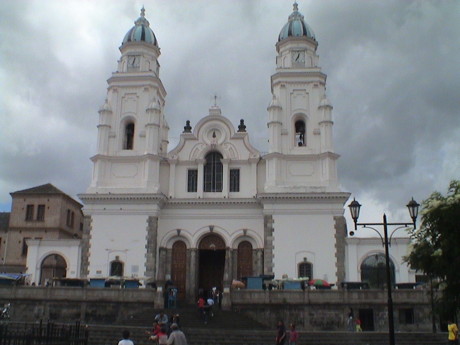 We
then went on a short joy ride south on the Pan American highway. We
went as far as Guaylabamba which turned out to be a pretty large
town, probably larger than Cayambe. Then we turned back north and
took a side trip to El Quinche. This is a picture of the church in
El Quinche, it is a pretty big one and it faces a large park as is
typical for Latin American towns.
We
then went on a short joy ride south on the Pan American highway. We
went as far as Guaylabamba which turned out to be a pretty large
town, probably larger than Cayambe. Then we turned back north and
took a side trip to El Quinche. This is a picture of the church in
El Quinche, it is a pretty big one and it faces a large park as is
typical for Latin American towns.
I couldn't walk around much but driving is ok, so we headed back
north toward Cayambe and the Hacienda. I've gotten used to driving
the little rental car and to the habits of Ecuadorian drivers so
that they aren't freaking me out as much. The car itself is
actually pretty good if not a little gutless. We drove for a week
on 5 gallons of gas. The suspension is a little stiff, but that is
probably good for bad roads.
Tuesday, August 3, 2010, Hacienda Guachala, Ecuador, about 2100
EST (GMT-5)
My ankle was much better this morning. I still fell some pain,
but not the stabbing kind that I had felt for the last two days. I
can actually walk in a more or less normal fashion.
Since Sandy, Eric and I are the only guests at the Hacienda,
it's pretty quiet here. The staff took the opportunity to oil the
floor in the dining room. It smelled like diesel fuel in there so
we had dinner in the library last night. Eric and I watched a Twins
vs. Rays baseball game on DirectTV in the Library during and after
dinner. Other than that, it was a pretty normal evening.
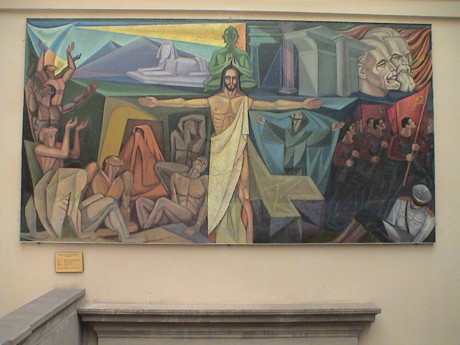 The task for today was to
drive to Quito to visit the Instituto Nacional de Patrimonio
Cultural (INPC) to request permission to export Sandy's obsidian
samples for analysis in the US. The INCP is in an old colonial
style mansion right downtown. I waited in the lobby as the office
that Sam and Sandy went to was really small and I wouldn't
understand a word of the Spanish used anyway. This painting, called
the "Historia de la Humiaidad" or history of humanity. It has a
sort of a odd cultural leaning that would not be found in the US,
especially down the right side with Lenin, Marx and the Soviet
worker/army theme.
The task for today was to
drive to Quito to visit the Instituto Nacional de Patrimonio
Cultural (INPC) to request permission to export Sandy's obsidian
samples for analysis in the US. The INCP is in an old colonial
style mansion right downtown. I waited in the lobby as the office
that Sam and Sandy went to was really small and I wouldn't
understand a word of the Spanish used anyway. This painting, called
the "Historia de la Humiaidad" or history of humanity. It has a
sort of a odd cultural leaning that would not be found in the US,
especially down the right side with Lenin, Marx and the Soviet
worker/army theme.
We were expecting some grief but we didn't get any. The export
was approved and they'll have the samples prepared and sealed for
shipment by tomorrow afternoon. Sandy will be hand carrying
them.
Sam hitched a ride with us and we drove up to his family's house
in Quito for an excellent lunch. Sam then packed some stuff and he
came back to the Hacienda with us. He needs to do some negotiation
with Diego concerning next year's field school.
Sandy started scanning various unit excavation reports in an
attempt to preserve the hardcopy of this data while it still
exists.
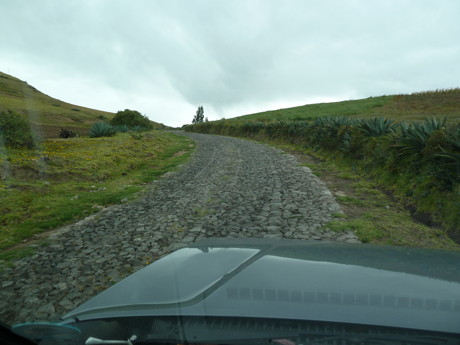 Before Sandy
got very far with scanning, Sam wanted to get a better look at the
possible Inka road that we hiked to a couple of days ago. This
time, we drove up around the hill that the "road" is carved into.
We drove south to Cangahua and then back north on a cobble road
until we got to the top of that hill, then down a dirt road to a
farm at the end.
Before Sandy
got very far with scanning, Sam wanted to get a better look at the
possible Inka road that we hiked to a couple of days ago. This
time, we drove up around the hill that the "road" is carved into.
We drove south to Cangahua and then back north on a cobble road
until we got to the top of that hill, then down a dirt road to a
farm at the end.
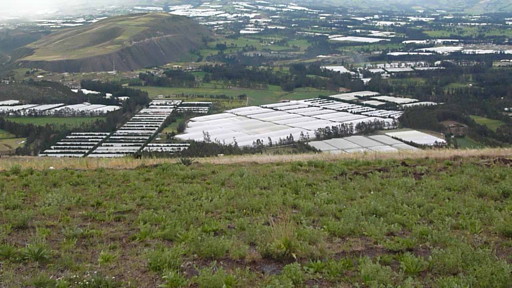 Then we
walked from the farm down the hill and found ourselves overlooking
some really seriously large rose farms in the flat land below. I
could recognize some of the roads and features in view and I knew
that we were right where we wanted to be.
Then we
walked from the farm down the hill and found ourselves overlooking
some really seriously large rose farms in the flat land below. I
could recognize some of the roads and features in view and I knew
that we were right where we wanted to be.
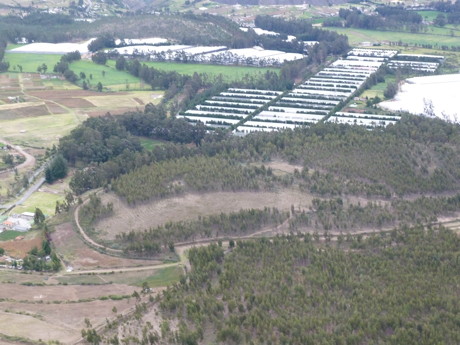 As
we got closer to the edge, Molinoloma came into view and, although
not in this photo, we could see the "watchtower" and the road going
through it from above. We could also see that the road went quite a
distance along the hill and disappeared from view around the hill
that we were standing on.
As
we got closer to the edge, Molinoloma came into view and, although
not in this photo, we could see the "watchtower" and the road going
through it from above. We could also see that the road went quite a
distance along the hill and disappeared from view around the hill
that we were standing on.
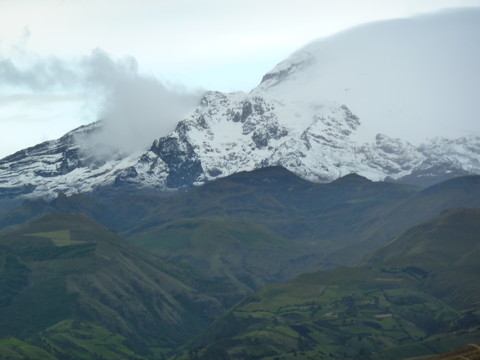 It
was cold and windy up on that hill, but not nearly as cold and
windy as it was on Cayambe. Just as we were leaving, the clouds
blew off the volcano so that we could see most of it. Anybody up
there was MUCH colder than we were. That puppy is 18,000 ft
high.
It
was cold and windy up on that hill, but not nearly as cold and
windy as it was on Cayambe. Just as we were leaving, the clouds
blew off the volcano so that we could see most of it. Anybody up
there was MUCH colder than we were. That puppy is 18,000 ft
high.
We returned to the Hacienda at about 1800 so that Sam could meet
with Diego Bonifaz and then five of us (myself, Sandy, Sam, Eric
and David) went out to dinner to a spot on the other side of the
town of Cayambe. It was a small restaurant run by an English couple
and it was very good. We then returned to the Hacienda to start a
fire in the fireplace, update this diary and crash.
Wednesday, August 4, 2010, Hacienda Guachala, Ecuador, about
1730 EST (GMT-5)
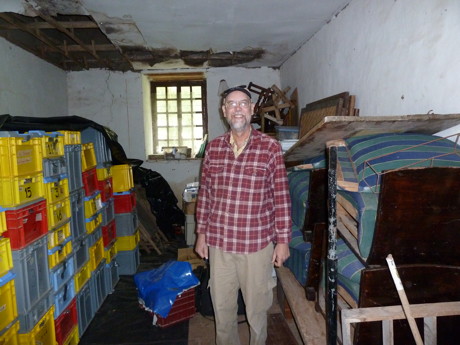 Today
was a clean up day. Eric is flying home tomorrow so we needed to
pack his stuff back in the store room and we also packed away stuff
we had in the room that we had needed but were done with. We still
have two crates of files that belong to Sam and a project scanner.
The rest of it has been returned minus 57 obsidian pieces that
Sandy will take home for analysis.
Today
was a clean up day. Eric is flying home tomorrow so we needed to
pack his stuff back in the store room and we also packed away stuff
we had in the room that we had needed but were done with. We still
have two crates of files that belong to Sam and a project scanner.
The rest of it has been returned minus 57 obsidian pieces that
Sandy will take home for analysis.
There will be some big wigs coming by to see the collection
Friday so that Diego has promised to fix the roof.
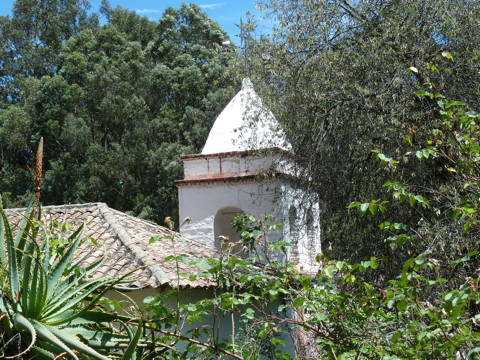 After we left the store
room, or bodega, Sandy proceeded to snap pictures of the Hacienda.
This is a photo of the bell tower of the "old" chapel which is
actually used for services once in a while. The chapel is part of
the original 1540's era construction. The larger church was built
in 1938, but it was converted to a museum and then it was pretty
much gutted. We used it for a few days as lab space.
After we left the store
room, or bodega, Sandy proceeded to snap pictures of the Hacienda.
This is a photo of the bell tower of the "old" chapel which is
actually used for services once in a while. The chapel is part of
the original 1540's era construction. The larger church was built
in 1938, but it was converted to a museum and then it was pretty
much gutted. We used it for a few days as lab space.
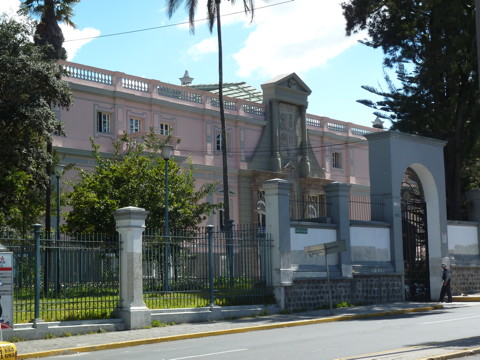 After lunch, we took Eric back
to the Jardin del Sol where he will stay the night in Quito before
he leaves early tomorrow morning. I also dropped Sandy off at the
INCP so that she could pick up the files. Even before I had dropped
Eric off less than a mile away, Sandy called and said that she had
the stuff so I drove back by the ICNP to pick her up. The INPC is
housed in a colonial style mansion smack in the middle of
Quito.
After lunch, we took Eric back
to the Jardin del Sol where he will stay the night in Quito before
he leaves early tomorrow morning. I also dropped Sandy off at the
INCP so that she could pick up the files. Even before I had dropped
Eric off less than a mile away, Sandy called and said that she had
the stuff so I drove back by the ICNP to pick her up. The INPC is
housed in a colonial style mansion smack in the middle of
Quito.
Then we made our way out of town. Gas was even cheaper in Quito,
$1.98/gal.
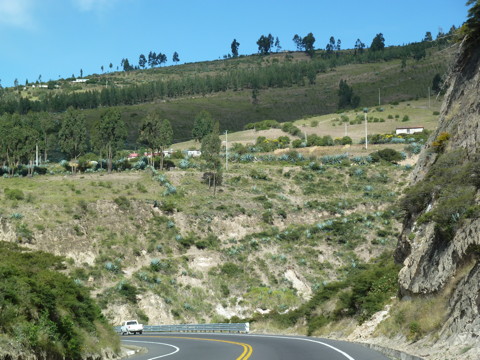 This is a typical
view of the Pan American highway on the eastern side of the
Guaylabamba basin, a 1000+ meter deep ravine that separates the
eastern and western ranges of the Andes in this area. The farmers
scratch out a living on any spot of dirt that they can. The highway
itself is good and there are police everywhere. We saw several
drivers pulled over on the way back. Seeing as how many crazy
drivers are here, the police have easy pickings. The speed limits
are 80 kph in some areas, but I was cruising at 65 or so in most
places and just letting folks blow by me. These folks will pass
anywhere, double yellow not withstanding, even on blind curves. I
just slid over to the right to give them some room. Sometimes they
will pass against opposing passing traffic meaning that there can
be four vehicles abreast on this road.
This is a typical
view of the Pan American highway on the eastern side of the
Guaylabamba basin, a 1000+ meter deep ravine that separates the
eastern and western ranges of the Andes in this area. The farmers
scratch out a living on any spot of dirt that they can. The highway
itself is good and there are police everywhere. We saw several
drivers pulled over on the way back. Seeing as how many crazy
drivers are here, the police have easy pickings. The speed limits
are 80 kph in some areas, but I was cruising at 65 or so in most
places and just letting folks blow by me. These folks will pass
anywhere, double yellow not withstanding, even on blind curves. I
just slid over to the right to give them some room. Sometimes they
will pass against opposing passing traffic meaning that there can
be four vehicles abreast on this road.
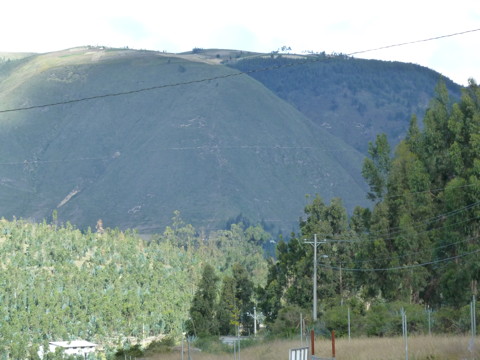 We stopped
near the turnoff to the Hacienda so that Sandy could get some
pictures of an obvious trail. It is the faint horizontal line
across the face of the hill. I noticed this feature last year and
pointed it out, but everybody thought it was just some contemporary
trail cut into the hillside. I don't see why anybody but the Inka
would do this. They liked to be high where they could see what was
going on and skirting the hillsides is a way to move troops without
having to pass through populated areas and perhaps having to
skirmish along the way. The spot we climbed is around a fold in the
hill to the right. I am betting that the Pambamarca field school
will investigate this feature more fully next year.
We stopped
near the turnoff to the Hacienda so that Sandy could get some
pictures of an obvious trail. It is the faint horizontal line
across the face of the hill. I noticed this feature last year and
pointed it out, but everybody thought it was just some contemporary
trail cut into the hillside. I don't see why anybody but the Inka
would do this. They liked to be high where they could see what was
going on and skirting the hillsides is a way to move troops without
having to pass through populated areas and perhaps having to
skirmish along the way. The spot we climbed is around a fold in the
hill to the right. I am betting that the Pambamarca field school
will investigate this feature more fully next year.
We made our way back to Cayambe to get some Coke Zero, more
chocolate, get the store room key duplicated again (2 more copies)
and get some hardcopy photocopies of the letter that the ICNP gave
Sandy. Then it was back to the Hacienda so that Sandy could get on
the Internet and register for fall classes. That's enough for one
day.
We don't have a plan for tomorrow. There will be nobody else
here that we know but Sam should be back on Friday so that we can
give him his files.
Thursday, August 5, 2010, Hacienda Guachala, Ecuador, about
1630 EST (GMT-5)
I am beginning to like the weather in the Ecuadorian highlands.
It is variable, but usually cool and dry. It doesn't get too hot,
never humid. There are few bugs. It is often windy and it rains,
but not for very long. This is the dry season, it certainly rains
more during the wet season.
I am also liking the car we rented. It has enough power to get
around and that model, basically a Geo Tracker, has a good
reputation here for getting places that other 4WD cars can't. The
body work isn't real heavy so that it will probably dent easily and
there isn't much room inside, but for two, it's fine. It has lots
of headroom which is important to me and the seats are
comfortable.
My ankle appears to have healed as of this morning. I don't feel
anything from there now. However, some of the bug bites around my
ankles that I got in Belize STILL itch big time. Those were some
nasty critters.
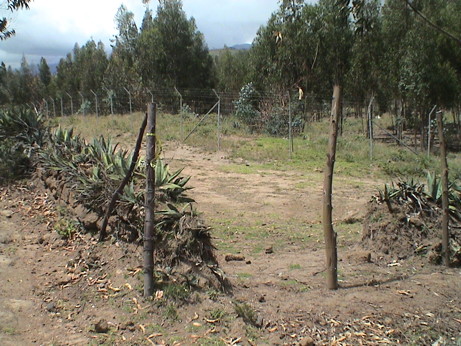 Sandy wanted to see the claimed Inka watch tower site and my ankle
appeared good to go so we hiked up there this morning.
Sandy wanted to see the claimed Inka watch tower site and my ankle
appeared good to go so we hiked up there this morning.
The way up there is pretty straightforward. We climbed the
Molinoloma dirt road and onto the the perimeter road
counterclockwise past the storehouse site trail to the backside of
the hill. This fence would normally block access to the trail.
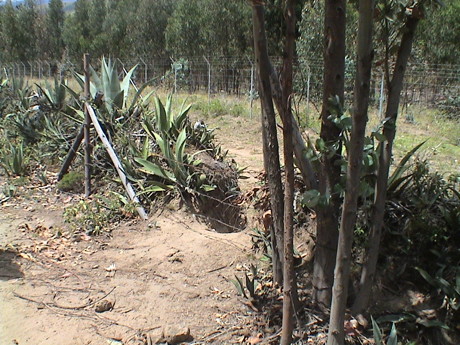 However
about 35 meters further along the road is this gap in the wall
where the fence is low enough to step over.
However
about 35 meters further along the road is this gap in the wall
where the fence is low enough to step over.
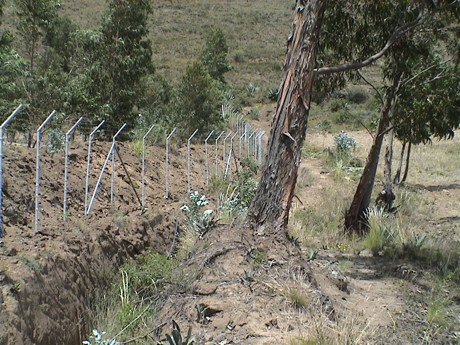 Then
the path extends next to a deep drainage ditch along another more
substantial fence.
Then
the path extends next to a deep drainage ditch along another more
substantial fence.
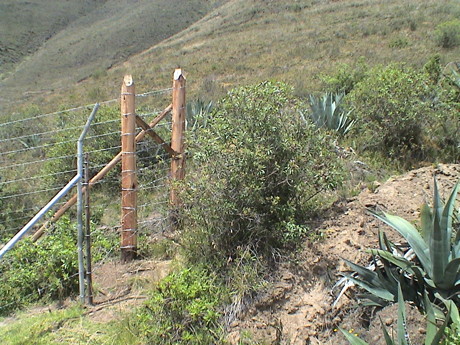 At the
corner of that fence are some cisterns and a trail going along the
back side.
At the
corner of that fence are some cisterns and a trail going along the
back side.
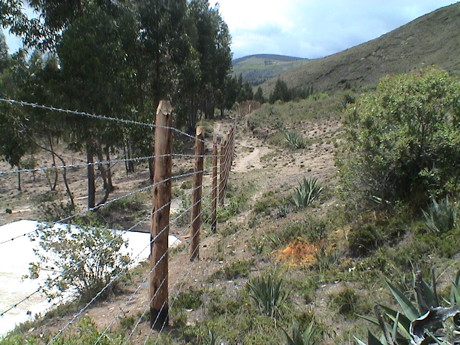 The
trail along the backside of the fence extends for a distance but we
only had to go past the remnants of a ravine and the vegetation
growing in it.
The
trail along the backside of the fence extends for a distance but we
only had to go past the remnants of a ravine and the vegetation
growing in it.
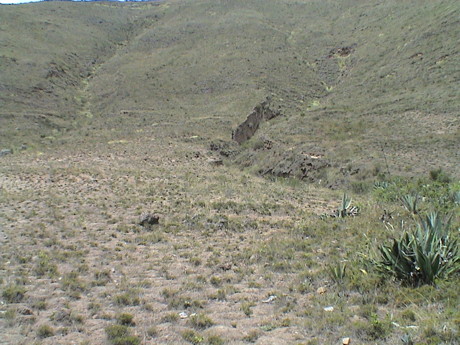 Once
past the lower stretches of the ravine, the vegetation clears and
the path is straight uphill over cangahua block bedrock.
Once
past the lower stretches of the ravine, the vegetation clears and
the path is straight uphill over cangahua block bedrock.
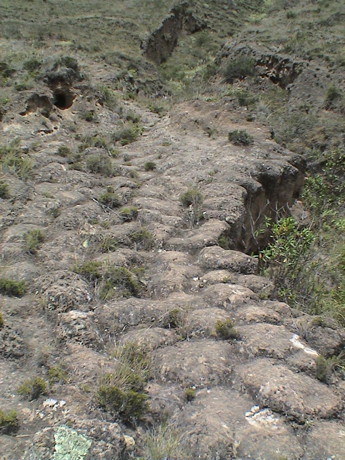 These
looks a little like set stones, but I think that they are a layer
of compacted ash that mudcracked and then the cracks filled with
wind blown dirt. They do make a very good cobbled road though. If
the Inka wanted a path here, they would run it here as there is
literally no work to do.
These
looks a little like set stones, but I think that they are a layer
of compacted ash that mudcracked and then the cracks filled with
wind blown dirt. They do make a very good cobbled road though. If
the Inka wanted a path here, they would run it here as there is
literally no work to do.
Two or three rows of stones near the edge of the ravine are
smoother than the ones just to the left. I suspect that the wear is
evidence of abrasion by people or animals.
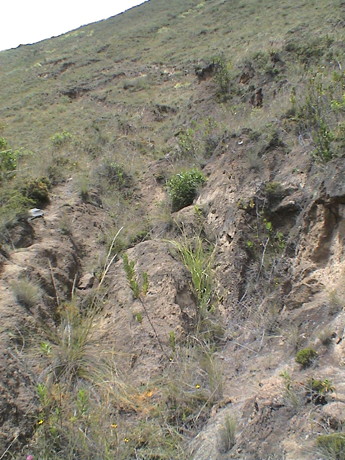 A little
higher up the hill, the trail gets rougher. There is still evidence
of wear but it might also be due to the flow of water down the
little gullies that also might be a trail.
A little
higher up the hill, the trail gets rougher. There is still evidence
of wear but it might also be due to the flow of water down the
little gullies that also might be a trail.
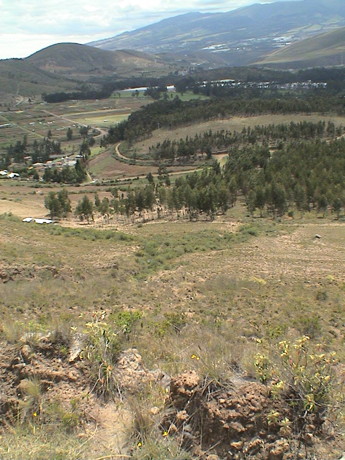 This
"trail" leads directly through the "watch tower" which is clearly a
fabricated structure. Rocks and mud have been packed into some wall
features that have no obvious natural explanation for
existence.
This
"trail" leads directly through the "watch tower" which is clearly a
fabricated structure. Rocks and mud have been packed into some wall
features that have no obvious natural explanation for
existence.
The whole path uphill to the site including the last part of the
road around Molinoloma can be seen in this photo.
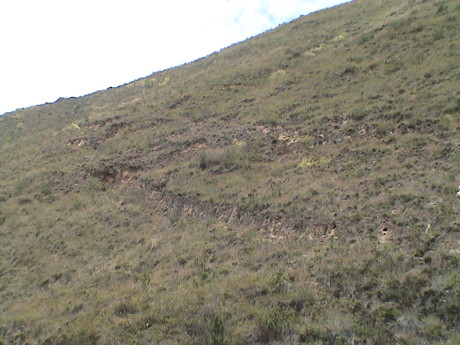 The "path" extends through the watch tower site and up the hill
and across the smaller ravine. It follows a zig zag path up the
hill for four or five switchbacks before we stopped following it a
few days ago. Sandy and I didn't climb any higher than the watch
tower. It took us about 45 minutes to drag our 60 year old bodies
up this high and we decided not to tempt fate by going any higher.
Besides it was threatening to rain more (it had been raining much
of the morning) so we elected to go downhill to get some lunch.
The "path" extends through the watch tower site and up the hill
and across the smaller ravine. It follows a zig zag path up the
hill for four or five switchbacks before we stopped following it a
few days ago. Sandy and I didn't climb any higher than the watch
tower. It took us about 45 minutes to drag our 60 year old bodies
up this high and we decided not to tempt fate by going any higher.
Besides it was threatening to rain more (it had been raining much
of the morning) so we elected to go downhill to get some lunch.
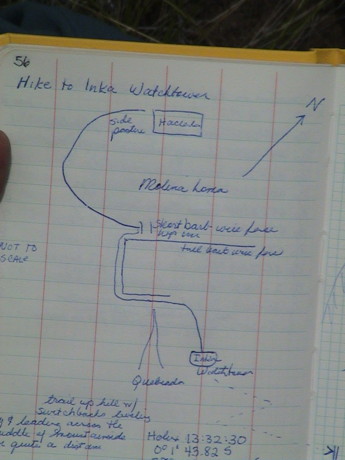 While we
were up there, Sandy, being the good archaeological student,
sketched a map in her notebook of the general path up there.
While we
were up there, Sandy, being the good archaeological student,
sketched a map in her notebook of the general path up there.
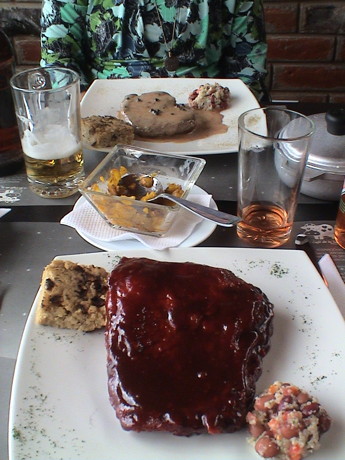 When we got back
to the Hacienda, we elected to drive to El Cafe de la Vaca. We had
tried to get dinner there twice before but it was closed both
times. It turns out that they don't serve dinner, just breakfast
and lunch. They have only been open for a week, but the place was
about half full. Sandy ordered a steak, I got BBQ ribs. Both were
excellent. The meal was not cheap, it cost about $40 with tax and
tip but it was really good.
When we got back
to the Hacienda, we elected to drive to El Cafe de la Vaca. We had
tried to get dinner there twice before but it was closed both
times. It turns out that they don't serve dinner, just breakfast
and lunch. They have only been open for a week, but the place was
about half full. Sandy ordered a steak, I got BBQ ribs. Both were
excellent. The meal was not cheap, it cost about $40 with tax and
tip but it was really good.
When we got back to the Hacienda, we both crashed for a bit.
We'll have dinner here in the Hacienda. Sam and Ana are here
through tomorrow afternoon.
Friday, August 6, 2010, Hacienda Guachala, Ecuador, about 1230
EST (GMT-5)
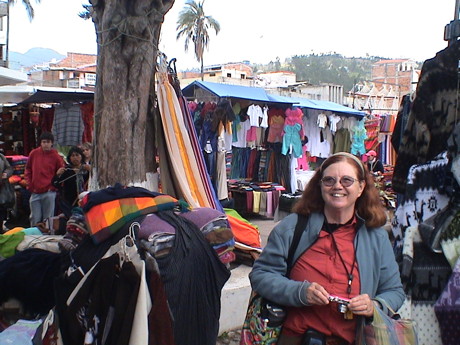 This morning we took a
quick trip to Otavalo to do some more shopping for tourist type
stuff. We hopped in the car a little after 0800 and were at the
market in an hour or so. It would have been quicker if I had not
turned off the Pan American a few blocks too soon. We got lost in
old town Otavalo and sort of wandered around until we stumbled on a
street we recognized. We then found a parking lot (parqueadero)
which cost $1 for all day. At least the car wasn't on the street.
Car theft is a problem here. We walked a block to the market and
snagged goodies for about an hour. I got a couple of Andean type
wool hats for $5 each and Sandy did some of her Christmas shopping
but I'll bet that some of that stuff doesn't actually get given
away. We then walked back to the car and drove back to the
Hacienda. Sandy examined her loot on the way back and pronounced
herself satisfied.
This morning we took a
quick trip to Otavalo to do some more shopping for tourist type
stuff. We hopped in the car a little after 0800 and were at the
market in an hour or so. It would have been quicker if I had not
turned off the Pan American a few blocks too soon. We got lost in
old town Otavalo and sort of wandered around until we stumbled on a
street we recognized. We then found a parking lot (parqueadero)
which cost $1 for all day. At least the car wasn't on the street.
Car theft is a problem here. We walked a block to the market and
snagged goodies for about an hour. I got a couple of Andean type
wool hats for $5 each and Sandy did some of her Christmas shopping
but I'll bet that some of that stuff doesn't actually get given
away. We then walked back to the car and drove back to the
Hacienda. Sandy examined her loot on the way back and pronounced
herself satisfied.
Sam and the government representative were up at the store room
when we arrived to examine the stored artifacts and he appeared
happy as well. The new ceiling in the store room looked pretty
good. Sam still has a lot to do before he leaves for Quito this
afternoon. Oscar is here to help too. Oscar is an Ecuadorian who
will be the PAP representative to the government while the
directors are not here.
Sandy is already planning to be back here next year and Sam
mentioned that he wants us to be staff for the field school next
year. We'll see how this works out.
We are kicking back for the afternoon. Tomorrow morning, we'll
pack for the transfer to Quito. We're going to unload at the El
Arupo and then return the rental car. We'll have good internet
access tomorrow afternoon and evening, after that we go into dark
territory for both internet and cell phone during the flight home
on Sunday.
Saturday, August 7, 2010, Hostel El Aurpo, Quito, Ecuador,
about 1600 EST (GMT-5)
We left the Hacienda at about 1100 this morning, drove to Quito,
filled the car with gas and parked at the Hostel El Arupo where we
unloaded. We got our room and then returned the rental car to the
airport with no difficulty. It is scary that I am beginning to be
able to navigate in Quito although Sandy did have the Maps app on
her iPad running.
We took a cab back to the hostel and then went on a walk to a
couple of stores on Amazonia street maybe a half a mile from the
hostel. Sandy did some serious damage at one of them. As we
returned it started to rain but we got here without getting
seriously wet. We're going to rest for the afternoon, get some
dinner at Rodriguez and crash early. We'll have to catch at cab at
0500 to make our flight.
Sunday, August 8, 2010, In flight, about 1930 PST (GMT-7)
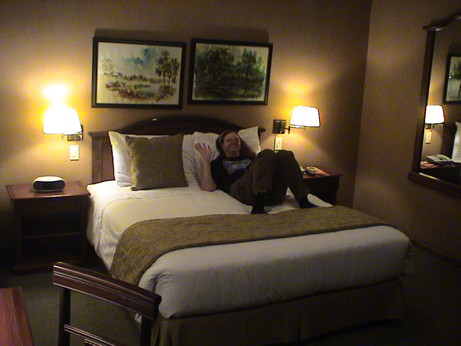 It
is 0730 and we were supposed to be on an airplane, but instead, we
are in the Dann Carlton hotel in Quito. Our flight was to go 1000
km south to Lima, then we would layover 5 hours and then fly 1000
km north passing Quito and stopping in San Salvador for another 1
hour layover and then to LAX arriving 5 minutes before midnight.
This flight was long, but much less expensive than other
flights.
It
is 0730 and we were supposed to be on an airplane, but instead, we
are in the Dann Carlton hotel in Quito. Our flight was to go 1000
km south to Lima, then we would layover 5 hours and then fly 1000
km north passing Quito and stopping in San Salvador for another 1
hour layover and then to LAX arriving 5 minutes before midnight.
This flight was long, but much less expensive than other
flights.
However, the flight was overbooked and TACA offered a later
flight at 1400 that arrived in LAX 10 minutes after the original
flight. They also put us up in an upscale hotel for the morning,
gave us a voucher for breakfast and lunch and vouchers for taxi
here and back. They also offered us $250 flight vouchers each. We
bit. We still have three flights, Quito to San Jose, then to
Guatemala City and then to LAX but we don't get off the airplane in
Guatemala City.
We've just had the largest breakfast that I've eaten in a long
time and are resting in our room. We have a phone and high speed
internet which I haven't experienced since we got here.
We'll be leaving at noon local time to return to the airport.
We've been checked in and have paid our departure fees so that all
we need to do is drop our bags and go through security.
We left the hotel right at noon and returned to the airport and
checked our bags, went through immigration and security and found
the gate. When I checked with the gate attendant to make sure that
the gate was right (the sign said Medelin Columbia), they
wanted our boarding passes. They stapled a new boarding pass on the
old one. We had been upgraded to business class.
After we got on the flight, they said something about Guayaquil.
It turns out that this flight as a stop too in Guayaquil, about 35
minutes away. We departed Guayaquil headed for San Jose, Costa
Rica. Since the 2nd major leg also has a stop at Guatemala City,
this is a four stop trip.
The business class seats have 110 VAC electrical outlets, but
neither of them work. The sockets are worn out and way too loose.
We're in the first row so our leg room isn't quite as good as the
seats behind us, but it is a damn sight better than coach. The
seats are wider too.
The food is MUCH better and presented better as well. It's been
a LONG time since I flew in business or first class.
As we neared San Jose, they called our connecting flight to be
at gate 7. We pulled into gate 7 so I was pretty sure that we
weren't going to miss our flight. Since the flight terminated at
San Jose, everyone had to get off. When we got back on, we were in
coach. It was a lot more cramped.
When the flight got to Guatemala City, everybody had to get off
again. Transit passengers (us) had to go through a TSA mandated
screen at the gate. Then we waited for a bit and boarded yet again.
I set my watch and iOS devices to Los Angeles time. If I believe
the flight time given by the flight crew, we should touch down at
LAX at about 2345, just the same time as our original flight plan
before we allowed ourselves to be bumped.
Monday, August 9, 2010, Torrance CA, about 0130 PDT
(GMT-7)
We're home with all our luggage. The flight came in at the same
time as our originally scheduled flight. Neither Zack or Charlie
were able to meet us so we took a cab home. Now it's time to go to
bed.
This page has been accessed times since July 17, 2010
times since July 17, 2010
© 2010 George Schreyer
Created July 17, 2010
Last Updated August 9, 2010
 After a true red-eye,
we've made it to Quito. Our LACSA flight left Terminal 2 at LAX at
about 0230. I got a little sleep before we left the house and a
little more on the airplane on the first leg to San Jose, Costa
Rica. We had an hour layover and then a 2 hour flight to Quito.
Then a $7 cab ride to the Hostel Alcala in the Mariscal district,
not far from the places we stayed last year. We grabbed
an early dinner at Rodriguez, an inexpensive and very good taco
place a few blocks away. Then I settled down to write in this page
and Sandy crashed. She had the help of a beer.
After a true red-eye,
we've made it to Quito. Our LACSA flight left Terminal 2 at LAX at
about 0230. I got a little sleep before we left the house and a
little more on the airplane on the first leg to San Jose, Costa
Rica. We had an hour layover and then a 2 hour flight to Quito.
Then a $7 cab ride to the Hostel Alcala in the Mariscal district,
not far from the places we stayed last year. We grabbed
an early dinner at Rodriguez, an inexpensive and very good taco
place a few blocks away. Then I settled down to write in this page
and Sandy crashed. She had the help of a beer. We couldn't
stay at Hostel Alcala for another night as the place was fully
reserved so we moved about a block away to the Hostel El Aurpo.
This place is a only a little more expensive by $6 but it nicer
inside. However Alcala was nice enough.
We couldn't
stay at Hostel Alcala for another night as the place was fully
reserved so we moved about a block away to the Hostel El Aurpo.
This place is a only a little more expensive by $6 but it nicer
inside. However Alcala was nice enough. This is the view
looking out our bedroom door. The hostel is very nice inside. At
the end of the hall is a lounge and TV room.
This is the view
looking out our bedroom door. The hostel is very nice inside. At
the end of the hall is a lounge and TV room. After we checked in, we went to
plan B for the rest of the day. We took a walk to Saturday flea
market near the Banco Central. This is a shot looking west to the
mountain range between Quito and the costal plains. Although it
doesn't show in this photo, the cable car that we rode last year
goes right up that mountainside.
After we checked in, we went to
plan B for the rest of the day. We took a walk to Saturday flea
market near the Banco Central. This is a shot looking west to the
mountain range between Quito and the costal plains. Although it
doesn't show in this photo, the cable car that we rode last year
goes right up that mountainside. On the way back, we passed through
Plaza Foch which is the central party spot for the Mariscal
district. This place tends to get quite loud at night. Fortunately,
the Hostel Alcala was just far enough from the action that we could
hear a mix of several sources of loud music, but the combination
was not loud enough to keep us awake. We'll see tonight what the
noise level at the Hostel El Arupo is.
On the way back, we passed through
Plaza Foch which is the central party spot for the Mariscal
district. This place tends to get quite loud at night. Fortunately,
the Hostel Alcala was just far enough from the action that we could
hear a mix of several sources of loud music, but the combination
was not loud enough to keep us awake. We'll see tonight what the
noise level at the Hostel El Arupo is. My how
plans can change in a day. We had given up on the train ride for
Saturday, but decided to try again on Sunday since we had nothing
else planned. We got up at 0600, caught a cab at about 0645 and
arrived at the station just before 0700 to get our tickets. The
station wasn't even open yet.
My how
plans can change in a day. We had given up on the train ride for
Saturday, but decided to try again on Sunday since we had nothing
else planned. We got up at 0600, caught a cab at about 0645 and
arrived at the station just before 0700 to get our tickets. The
station wasn't even open yet. When we got
there, the crew was hooking this Alstrom B-B-B diesel loco to a
short train. I'll have more to say about this locomotive later.
When we got
there, the crew was hooking this Alstrom B-B-B diesel loco to a
short train. I'll have more to say about this locomotive later. There is a
2-8-0 outside frame narrow gauge steam locomotive on a track at the
station, but it is currently non-operational. It needs some kind of
work and is expected to run again in a couple of years.... in
Ecuador time. This could mean anytime between two years and
never.
There is a
2-8-0 outside frame narrow gauge steam locomotive on a track at the
station, but it is currently non-operational. It needs some kind of
work and is expected to run again in a couple of years.... in
Ecuador time. This could mean anytime between two years and
never. We thought
that we were going to take this fairly modern railbus. It left
promptly at 0800 without us on it. Our tickets were for the diesel
locomotive train, the loco and three cars.
We thought
that we were going to take this fairly modern railbus. It left
promptly at 0800 without us on it. Our tickets were for the diesel
locomotive train, the loco and three cars. This is
a sign at Tambillo station showing the southern part of the route
from Quito back to Guayaquil (Duran). The line is broken in a
couple of places.
This is
a sign at Tambillo station showing the southern part of the route
from Quito back to Guayaquil (Duran). The line is broken in a
couple of places. At the
Machachi Station, we were met by some dancers of various ages. They
performed some traditional dances and then we were given a sandwich
for lunch.
At the
Machachi Station, we were met by some dancers of various ages. They
performed some traditional dances and then we were given a sandwich
for lunch. After lunch we had the
option of going on a complementary farm tour for a couple of hours
before our bus ride back to Quito. We had nothing better to do so
we took the tour. The "complementary" part meant that we had to buy
a ticket for $2/head. There wasn't much to see there besides some
well maintained grounds, a herb garden, and some farm animals. This
"farm" was clearly there to harvest money from tourists.
After lunch we had the
option of going on a complementary farm tour for a couple of hours
before our bus ride back to Quito. We had nothing better to do so
we took the tour. The "complementary" part meant that we had to buy
a ticket for $2/head. There wasn't much to see there besides some
well maintained grounds, a herb garden, and some farm animals. This
"farm" was clearly there to harvest money from tourists. We
walked back the short distance to the station and I noticed that on
the other side was a small, manually operated turntable on a stub
siding. This guy is too light weight for the diesel, besides it is
double ended and doesn't need a turntable. It is too short for the
steamer and tender so it must be there to turn the railbuses.
We
walked back the short distance to the station and I noticed that on
the other side was a small, manually operated turntable on a stub
siding. This guy is too light weight for the diesel, besides it is
double ended and doesn't need a turntable. It is too short for the
steamer and tender so it must be there to turn the railbuses. We did get to the
Hacienda Guachala at about 1700 but there was nobody around. It
took some wandering around the grounds that could get us keys.
These photos are pretty dark because my camcorder doesn't have a
flash, I'll get some better ones in the coming days. We are in a
much larger room this year. Eric is in the room we had last
year.
We did get to the
Hacienda Guachala at about 1700 but there was nobody around. It
took some wandering around the grounds that could get us keys.
These photos are pretty dark because my camcorder doesn't have a
flash, I'll get some better ones in the coming days. We are in a
much larger room this year. Eric is in the room we had last
year. The room has a queen
and a double bed. We brought one sleeping bag this year instead of
two. It is unfolded on the queen bed for warmth.
The room has a queen
and a double bed. We brought one sleeping bag this year instead of
two. It is unfolded on the queen bed for warmth. The room has a
fireplace and there is wood and kindling provided. The Hacienda is
generally a colder and more windy place that Quito. The hostels in
Quito didn't even have heat because it just isn't needed.
The room has a
fireplace and there is wood and kindling provided. The Hacienda is
generally a colder and more windy place that Quito. The hostels in
Quito didn't even have heat because it just isn't needed. While we were
waiting for the key to the store room that held the project
archives, Cristobal took us on a short tour of the changes that had
been made since last year. What used to be our lab has been turned
into a row of schoolrooms. The horse paddock has been allowed to
fill with grass and the rabbit hutches and chicken coops are no
longer occupied. The large room that we had used for a lecture hall
was filled with furniture destined for the school.
While we were
waiting for the key to the store room that held the project
archives, Cristobal took us on a short tour of the changes that had
been made since last year. What used to be our lab has been turned
into a row of schoolrooms. The horse paddock has been allowed to
fill with grass and the rabbit hutches and chicken coops are no
longer occupied. The large room that we had used for a lecture hall
was filled with furniture destined for the school. We left the
Hacienda in our rental car at about 1030 headed for Cayambe to buy
supplies at the Gran Aki market. That was the easy part. We also
needed some other stuff that wasn't all found.
We left the
Hacienda in our rental car at about 1030 headed for Cayambe to buy
supplies at the Gran Aki market. That was the easy part. We also
needed some other stuff that wasn't all found. After we got back at about 1400, we had a lunch of sandwiches and
then got to work. Eric and I started going through each of the
storage crates, some were very heavy, looking for obsidian for
Sandy and Eric's surface collection samples from years past. We
found some of it anyway. We set up in the church to allow Sandy to
examine and catalog the samples. She quit when it got dark as there
is good sunlight in the church but no artificial light.
After we got back at about 1400, we had a lunch of sandwiches and
then got to work. Eric and I started going through each of the
storage crates, some were very heavy, looking for obsidian for
Sandy and Eric's surface collection samples from years past. We
found some of it anyway. We set up in the church to allow Sandy to
examine and catalog the samples. She quit when it got dark as there
is good sunlight in the church but no artificial light. Since Sandy
needed some information from Sam before she could efficiently
continue sorting her samples and he was supposed to arrive around
noon, we elected to spend some time on Molina Loma, a site on a
hill above the Hacienda, where we were doing excavation last year.
This is what unit 27 looks like now after a year of exposure to the
weather. I thought it was going to be protected and filled, but it
appears that that did not happen.
Since Sandy
needed some information from Sam before she could efficiently
continue sorting her samples and he was supposed to arrive around
noon, we elected to spend some time on Molina Loma, a site on a
hill above the Hacienda, where we were doing excavation last year.
This is what unit 27 looks like now after a year of exposure to the
weather. I thought it was going to be protected and filled, but it
appears that that did not happen. Our plan was to do a
surface survey of obsidian samples on the back side of the hill.
These would have been washed down from the hilltop where the Inka
site was. The particular area that we picked was not forested and
mostly exposed bedrock and generally free of leaf litter so that a
surface survey would be easier. We found about a dozen pieces
total, mostly like this one just sitting fully exposed on a sand
filled depression where it washed to and stayed. These pieces are
extremely easy to see because the contrast so completely with the
surrounding soil.
Our plan was to do a
surface survey of obsidian samples on the back side of the hill.
These would have been washed down from the hilltop where the Inka
site was. The particular area that we picked was not forested and
mostly exposed bedrock and generally free of leaf litter so that a
surface survey would be easier. We found about a dozen pieces
total, mostly like this one just sitting fully exposed on a sand
filled depression where it washed to and stayed. These pieces are
extremely easy to see because the contrast so completely with the
surrounding soil. Since we didn't
have a lab, we set up in the church, built in 1938. The church
isn't secure, there are three doors without locks, but at least it
has good light and the roof is mostly intact. There is some
sunlight shining through in places, but I don't know how badly it
leaks. Next time we get some rain here, I'll go in there and take a
look.
Since we didn't
have a lab, we set up in the church, built in 1938. The church
isn't secure, there are three doors without locks, but at least it
has good light and the roof is mostly intact. There is some
sunlight shining through in places, but I don't know how badly it
leaks. Next time we get some rain here, I'll go in there and take a
look. I also
investigated the remnants of wiring in the church. When they ripped
out the dry rotted ceiling last year, the also ripped out the power
wires to the hanging lamps that ran down the center of the church.
The wiring was simply bundled up in the choir bay. There is a light
switch and an ungrounded outlet at the rear of the church. The
wiring for ALL of this stuff is not even close to US building
codes, but it seems to be normal for Ecuador.
I also
investigated the remnants of wiring in the church. When they ripped
out the dry rotted ceiling last year, the also ripped out the power
wires to the hanging lamps that ran down the center of the church.
The wiring was simply bundled up in the choir bay. There is a light
switch and an ungrounded outlet at the rear of the church. The
wiring for ALL of this stuff is not even close to US building
codes, but it seems to be normal for Ecuador. There is
a heavy gauge pair in the choir bay that snakes its way outside via
some chipped out adobe next to a window frame in the south bell
tower, out across the peak of the room just east of the bell
towers, down the other side and across a wall that connects the
church to the row of rooms that used to be the stable. There it
dives into a circuit breaker box. There are three circuit breakers,
all appear to be ON.
There is
a heavy gauge pair in the choir bay that snakes its way outside via
some chipped out adobe next to a window frame in the south bell
tower, out across the peak of the room just east of the bell
towers, down the other side and across a wall that connects the
church to the row of rooms that used to be the stable. There it
dives into a circuit breaker box. There are three circuit breakers,
all appear to be ON. There
could be power in the church, but there is some damage to the
wiring in the choir bay that needs to be repaired. It appears that
there may still be connectivity even with the damaged insulation.
Since all the breakers seem to be on the exposed wiring may be hot.
I dragged a table lamp from our room over to the church and plugged
it in and the circuit is indeed hot. The light switch is in the on
position so that the cut wiring bundle in the choir bay is probably
hot at the cut end too. I don't feel like messing with this and
getting fried in Ecuador. Some Ecuadorian electrician can patch
this back to their standards if we really need power in there.
There
could be power in the church, but there is some damage to the
wiring in the choir bay that needs to be repaired. It appears that
there may still be connectivity even with the damaged insulation.
Since all the breakers seem to be on the exposed wiring may be hot.
I dragged a table lamp from our room over to the church and plugged
it in and the circuit is indeed hot. The light switch is in the on
position so that the cut wiring bundle in the choir bay is probably
hot at the cut end too. I don't feel like messing with this and
getting fried in Ecuador. Some Ecuadorian electrician can patch
this back to their standards if we really need power in there. While Sandy was in
the church sorting through obsidian samples, I took the car up to
Mitad del Mundo (the middle of the world) where there is a monument
and marker for the equator. This marker was placed by the the IGM
in 2005 using geodesic GPS. It's latitude is 0.000. The longitude
is 78° 10 min 30 sec west. Sandy's GPS enabled camera nailed
the longitude, but it was off by 0.00003 deg in latitude. I also
got readings on the iPad, it read 0.00003654° latitude and
78.17506481° longitude. The elevation was 2728 meters which was
probably about 75 meters high. I was also recording my position
continually using Sandy's Holux GPS tracker module, but it doesn't
report it's logged data on the device. Sandy needs to download the
data file to see what it recorded. I also walked the equator line
at the monument, we'll see how well it's latitude points track.
While Sandy was in
the church sorting through obsidian samples, I took the car up to
Mitad del Mundo (the middle of the world) where there is a monument
and marker for the equator. This marker was placed by the the IGM
in 2005 using geodesic GPS. It's latitude is 0.000. The longitude
is 78° 10 min 30 sec west. Sandy's GPS enabled camera nailed
the longitude, but it was off by 0.00003 deg in latitude. I also
got readings on the iPad, it read 0.00003654° latitude and
78.17506481° longitude. The elevation was 2728 meters which was
probably about 75 meters high. I was also recording my position
continually using Sandy's Holux GPS tracker module, but it doesn't
report it's logged data on the device. Sandy needs to download the
data file to see what it recorded. I also walked the equator line
at the monument, we'll see how well it's latitude points track. I got up a little
earlier than normal, 0800, today to go on a hike with Eric and
Dennis. I didn't know when they were planing to leave, but I could
have slept in for another hour. However, it was bright, sunny and
warm outside. This is the view of the Hacienda plaza from just
outside our room. Straight back in the middle of the photo is the
library and internet room. To the right is a row of tables that is
used by the Hacienda restaurant for breakfast and lunch. Dinner is
served indoors when it is usually too cool outside.
I got up a little
earlier than normal, 0800, today to go on a hike with Eric and
Dennis. I didn't know when they were planing to leave, but I could
have slept in for another hour. However, it was bright, sunny and
warm outside. This is the view of the Hacienda plaza from just
outside our room. Straight back in the middle of the photo is the
library and internet room. To the right is a row of tables that is
used by the Hacienda restaurant for breakfast and lunch. Dinner is
served indoors when it is usually too cool outside. The hike was supposed to
go to two places but Dennis and I were both tired so we passed on
the 2nd destination. One of them was the site of a possible Inka
"watchtower" way up on the hillside on the largest hill behind the
Hacienda. When I took this photo, we hadn't located the structure
yet, it was another 50 meters or so up the very steep hill.
However, from here, there is a good view. The bare region on the
hill below is where Sandy and I surveyed a few days ago. That hill
is Molinoloma, the Inka site we helped excavate is just inside the
tree line on the top of the hill. The Hacienda is just on the other
side of the hill. The settlement to the left is the town of Buena
Esperanza.
The hike was supposed to
go to two places but Dennis and I were both tired so we passed on
the 2nd destination. One of them was the site of a possible Inka
"watchtower" way up on the hillside on the largest hill behind the
Hacienda. When I took this photo, we hadn't located the structure
yet, it was another 50 meters or so up the very steep hill.
However, from here, there is a good view. The bare region on the
hill below is where Sandy and I surveyed a few days ago. That hill
is Molinoloma, the Inka site we helped excavate is just inside the
tree line on the top of the hill. The Hacienda is just on the other
side of the hill. The settlement to the left is the town of Buena
Esperanza. This photo is taken from
the "watchtower" which is not much more than a couple of walls made
of piled up stone and mud. Eric is in the foreground, Dennis is
down the hill a little. However, there seemed to be a pathway that
ran right through this structure, whatever it really was.
This photo is taken from
the "watchtower" which is not much more than a couple of walls made
of piled up stone and mud. Eric is in the foreground, Dennis is
down the hill a little. However, there seemed to be a pathway that
ran right through this structure, whatever it really was. We followed the pathways
up the hill for some distance. They had been clearly used recently,
probably by grazing animals, as they were mostly clear of
vegetation and the rocks were rounded and eroded. At first, I
thought that these features might be slip fractures but slip
fractures do not zig-zag. The paths had many zig-zags continuing up
the hill further than we went. These could have been part of an
Inka "road."
We followed the pathways
up the hill for some distance. They had been clearly used recently,
probably by grazing animals, as they were mostly clear of
vegetation and the rocks were rounded and eroded. At first, I
thought that these features might be slip fractures but slip
fractures do not zig-zag. The paths had many zig-zags continuing up
the hill further than we went. These could have been part of an
Inka "road." After
returning to the Hacienda over Molinoloma, I ferried Eric into
Cayambe so that he could check into his hostel. We also picked up
our laundry. On the way back, I took a picture of the railroad
station at the junction of the Cangahua road and the Pan American
highway. Last year, we used to roadbed at the right as the way to
Loma Sandoval. If the Ecuadorian railroad wants to rebuild this
line, they have some work to do.
After
returning to the Hacienda over Molinoloma, I ferried Eric into
Cayambe so that he could check into his hostel. We also picked up
our laundry. On the way back, I took a picture of the railroad
station at the junction of the Cangahua road and the Pan American
highway. Last year, we used to roadbed at the right as the way to
Loma Sandoval. If the Ecuadorian railroad wants to rebuild this
line, they have some work to do. After we
returned to the room from dinner, we could hear a party going on in
the little town of Buena Esperanza near the Hacienda. We walked up
there and found a small group of young men dancing in the road and
generally blocking what little traffic there was. These guys were
pretty drunk already. Buena Esperanza was in the midst of their
festival. The group invited us to dance with then as we slowly made
our way up the street and onto a side street where the big party
was. We were offered whisky, Sandy accepted but I could not as I am
not allowed alcohol.
After we
returned to the room from dinner, we could hear a party going on in
the little town of Buena Esperanza near the Hacienda. We walked up
there and found a small group of young men dancing in the road and
generally blocking what little traffic there was. These guys were
pretty drunk already. Buena Esperanza was in the midst of their
festival. The group invited us to dance with then as we slowly made
our way up the street and onto a side street where the big party
was. We were offered whisky, Sandy accepted but I could not as I am
not allowed alcohol. The lighting is
not so good, but there was a big party going on with very loud
music and lots of dancing at a spot a few hundred yard off the
highway. There had to be 500 people there, most of them fully or
partially drunk. Sandy was offered chicha (a slightly alcoholic hot
drink made from corn) by many folks. I had to explain that I could
not drink due to a medical problem and they understood. It is
normally considered an insult to refuse chicha. We hung around
until Sandy got a little tipsy and then we wandered home.
The lighting is
not so good, but there was a big party going on with very loud
music and lots of dancing at a spot a few hundred yard off the
highway. There had to be 500 people there, most of them fully or
partially drunk. Sandy was offered chicha (a slightly alcoholic hot
drink made from corn) by many folks. I had to explain that I could
not drink due to a medical problem and they understood. It is
normally considered an insult to refuse chicha. We hung around
until Sandy got a little tipsy and then we wandered home. Today is race day. A motocross event has been scheduled at the
Hacienda. Most of the teams came in this morning and set up the pit
area in the pasture south of the Hacienda. The soccer field that we
surveyed with ground penetrating radar last year is an obstacle
course. The first race is quadratrack riders. The main event will
run for 50 laps, about 3 hours.
Today is race day. A motocross event has been scheduled at the
Hacienda. Most of the teams came in this morning and set up the pit
area in the pasture south of the Hacienda. The soccer field that we
surveyed with ground penetrating radar last year is an obstacle
course. The first race is quadratrack riders. The main event will
run for 50 laps, about 3 hours. At the transition from the pasture to the soccer field, there is a
small jump. Some of the riders were getting air at that spot, most
did not.
At the transition from the pasture to the soccer field, there is a
small jump. Some of the riders were getting air at that spot, most
did not. At about 1130
the motorcycle riders took a couple of practice laps and lined up
for the start. There has to be more than 50 of them.
At about 1130
the motorcycle riders took a couple of practice laps and lined up
for the start. There has to be more than 50 of them. The race was
apparently started in classes, I took this picture at the start
before the dust got so bad that photography was impractical.
Eventually the field spread out enough so that the dust often had a
chance to blow away before the next rider came through.
The race was
apparently started in classes, I took this picture at the start
before the dust got so bad that photography was impractical.
Eventually the field spread out enough so that the dust often had a
chance to blow away before the next rider came through. This is where
the riders come down the hill to start the run on the flat section.
Most of them were going pretty slowly here so I could get a clear
shot, I expected less caution.
This is where
the riders come down the hill to start the run on the flat section.
Most of them were going pretty slowly here so I could get a clear
shot, I expected less caution. At the jump,
most riders didn't get any air at all. A few did, but not as much
as some of the quadratrack riders did.
At the jump,
most riders didn't get any air at all. A few did, but not as much
as some of the quadratrack riders did. One thing
we look forward too each night is a fire in our fireplace. It not
only heats the room, but it provides some "atmosphere." Last year I
sometimes had problems getting a fire going, or if it sustained
itself, it didn't make a lot of heat. This year, I've figured it
out. This fire was so hot that I had to sit back about 10 ft or get
roasted. The secret is to collect sticks up to a half inch in
diameter. These are all over the grounds and are usually pretty
dry. They ignite easily and make enough heat to dry out the
somewhat wet firewood such that it will start to burn before the
kindling goes out. The second secret is to use a couple of larger
boards along the sides to support a log cabin style stack above the
kindling so that the fire can breath properly. This also leaves a
volume at the bottom where the hot coals can gather to make a layer
of glowing coals that will both emit heat into the room and heat
the new wood enough so that it can dry out too.
One thing
we look forward too each night is a fire in our fireplace. It not
only heats the room, but it provides some "atmosphere." Last year I
sometimes had problems getting a fire going, or if it sustained
itself, it didn't make a lot of heat. This year, I've figured it
out. This fire was so hot that I had to sit back about 10 ft or get
roasted. The secret is to collect sticks up to a half inch in
diameter. These are all over the grounds and are usually pretty
dry. They ignite easily and make enough heat to dry out the
somewhat wet firewood such that it will start to burn before the
kindling goes out. The second secret is to use a couple of larger
boards along the sides to support a log cabin style stack above the
kindling so that the fire can breath properly. This also leaves a
volume at the bottom where the hot coals can gather to make a layer
of glowing coals that will both emit heat into the room and heat
the new wood enough so that it can dry out too. We
then went on a short joy ride south on the Pan American highway. We
went as far as Guaylabamba which turned out to be a pretty large
town, probably larger than Cayambe. Then we turned back north and
took a side trip to El Quinche. This is a picture of the church in
El Quinche, it is a pretty big one and it faces a large park as is
typical for Latin American towns.
We
then went on a short joy ride south on the Pan American highway. We
went as far as Guaylabamba which turned out to be a pretty large
town, probably larger than Cayambe. Then we turned back north and
took a side trip to El Quinche. This is a picture of the church in
El Quinche, it is a pretty big one and it faces a large park as is
typical for Latin American towns. The task for today was to
drive to Quito to visit the Instituto Nacional de Patrimonio
Cultural (INPC) to request permission to export Sandy's obsidian
samples for analysis in the US. The INCP is in an old colonial
style mansion right downtown. I waited in the lobby as the office
that Sam and Sandy went to was really small and I wouldn't
understand a word of the Spanish used anyway. This painting, called
the "Historia de la Humiaidad" or history of humanity. It has a
sort of a odd cultural leaning that would not be found in the US,
especially down the right side with Lenin, Marx and the Soviet
worker/army theme.
The task for today was to
drive to Quito to visit the Instituto Nacional de Patrimonio
Cultural (INPC) to request permission to export Sandy's obsidian
samples for analysis in the US. The INCP is in an old colonial
style mansion right downtown. I waited in the lobby as the office
that Sam and Sandy went to was really small and I wouldn't
understand a word of the Spanish used anyway. This painting, called
the "Historia de la Humiaidad" or history of humanity. It has a
sort of a odd cultural leaning that would not be found in the US,
especially down the right side with Lenin, Marx and the Soviet
worker/army theme. Before Sandy
got very far with scanning, Sam wanted to get a better look at the
possible Inka road that we hiked to a couple of days ago. This
time, we drove up around the hill that the "road" is carved into.
We drove south to Cangahua and then back north on a cobble road
until we got to the top of that hill, then down a dirt road to a
farm at the end.
Before Sandy
got very far with scanning, Sam wanted to get a better look at the
possible Inka road that we hiked to a couple of days ago. This
time, we drove up around the hill that the "road" is carved into.
We drove south to Cangahua and then back north on a cobble road
until we got to the top of that hill, then down a dirt road to a
farm at the end. Then we
walked from the farm down the hill and found ourselves overlooking
some really seriously large rose farms in the flat land below. I
could recognize some of the roads and features in view and I knew
that we were right where we wanted to be.
Then we
walked from the farm down the hill and found ourselves overlooking
some really seriously large rose farms in the flat land below. I
could recognize some of the roads and features in view and I knew
that we were right where we wanted to be. As
we got closer to the edge, Molinoloma came into view and, although
not in this photo, we could see the "watchtower" and the road going
through it from above. We could also see that the road went quite a
distance along the hill and disappeared from view around the hill
that we were standing on.
As
we got closer to the edge, Molinoloma came into view and, although
not in this photo, we could see the "watchtower" and the road going
through it from above. We could also see that the road went quite a
distance along the hill and disappeared from view around the hill
that we were standing on. It
was cold and windy up on that hill, but not nearly as cold and
windy as it was on Cayambe. Just as we were leaving, the clouds
blew off the volcano so that we could see most of it. Anybody up
there was MUCH colder than we were. That puppy is 18,000 ft
high.
It
was cold and windy up on that hill, but not nearly as cold and
windy as it was on Cayambe. Just as we were leaving, the clouds
blew off the volcano so that we could see most of it. Anybody up
there was MUCH colder than we were. That puppy is 18,000 ft
high. Today
was a clean up day. Eric is flying home tomorrow so we needed to
pack his stuff back in the store room and we also packed away stuff
we had in the room that we had needed but were done with. We still
have two crates of files that belong to Sam and a project scanner.
The rest of it has been returned minus 57 obsidian pieces that
Sandy will take home for analysis.
Today
was a clean up day. Eric is flying home tomorrow so we needed to
pack his stuff back in the store room and we also packed away stuff
we had in the room that we had needed but were done with. We still
have two crates of files that belong to Sam and a project scanner.
The rest of it has been returned minus 57 obsidian pieces that
Sandy will take home for analysis. After we left the store
room, or bodega, Sandy proceeded to snap pictures of the Hacienda.
This is a photo of the bell tower of the "old" chapel which is
actually used for services once in a while. The chapel is part of
the original 1540's era construction. The larger church was built
in 1938, but it was converted to a museum and then it was pretty
much gutted. We used it for a few days as lab space.
After we left the store
room, or bodega, Sandy proceeded to snap pictures of the Hacienda.
This is a photo of the bell tower of the "old" chapel which is
actually used for services once in a while. The chapel is part of
the original 1540's era construction. The larger church was built
in 1938, but it was converted to a museum and then it was pretty
much gutted. We used it for a few days as lab space. After lunch, we took Eric back
to the Jardin del Sol where he will stay the night in Quito before
he leaves early tomorrow morning. I also dropped Sandy off at the
INCP so that she could pick up the files. Even before I had dropped
Eric off less than a mile away, Sandy called and said that she had
the stuff so I drove back by the ICNP to pick her up. The INPC is
housed in a colonial style mansion smack in the middle of
Quito.
After lunch, we took Eric back
to the Jardin del Sol where he will stay the night in Quito before
he leaves early tomorrow morning. I also dropped Sandy off at the
INCP so that she could pick up the files. Even before I had dropped
Eric off less than a mile away, Sandy called and said that she had
the stuff so I drove back by the ICNP to pick her up. The INPC is
housed in a colonial style mansion smack in the middle of
Quito. This is a typical
view of the Pan American highway on the eastern side of the
Guaylabamba basin, a 1000+ meter deep ravine that separates the
eastern and western ranges of the Andes in this area. The farmers
scratch out a living on any spot of dirt that they can. The highway
itself is good and there are police everywhere. We saw several
drivers pulled over on the way back. Seeing as how many crazy
drivers are here, the police have easy pickings. The speed limits
are 80 kph in some areas, but I was cruising at 65 or so in most
places and just letting folks blow by me. These folks will pass
anywhere, double yellow not withstanding, even on blind curves. I
just slid over to the right to give them some room. Sometimes they
will pass against opposing passing traffic meaning that there can
be four vehicles abreast on this road.
This is a typical
view of the Pan American highway on the eastern side of the
Guaylabamba basin, a 1000+ meter deep ravine that separates the
eastern and western ranges of the Andes in this area. The farmers
scratch out a living on any spot of dirt that they can. The highway
itself is good and there are police everywhere. We saw several
drivers pulled over on the way back. Seeing as how many crazy
drivers are here, the police have easy pickings. The speed limits
are 80 kph in some areas, but I was cruising at 65 or so in most
places and just letting folks blow by me. These folks will pass
anywhere, double yellow not withstanding, even on blind curves. I
just slid over to the right to give them some room. Sometimes they
will pass against opposing passing traffic meaning that there can
be four vehicles abreast on this road. We stopped
near the turnoff to the Hacienda so that Sandy could get some
pictures of an obvious trail. It is the faint horizontal line
across the face of the hill. I noticed this feature last year and
pointed it out, but everybody thought it was just some contemporary
trail cut into the hillside. I don't see why anybody but the Inka
would do this. They liked to be high where they could see what was
going on and skirting the hillsides is a way to move troops without
having to pass through populated areas and perhaps having to
skirmish along the way. The spot we climbed is around a fold in the
hill to the right. I am betting that the Pambamarca field school
will investigate this feature more fully next year.
We stopped
near the turnoff to the Hacienda so that Sandy could get some
pictures of an obvious trail. It is the faint horizontal line
across the face of the hill. I noticed this feature last year and
pointed it out, but everybody thought it was just some contemporary
trail cut into the hillside. I don't see why anybody but the Inka
would do this. They liked to be high where they could see what was
going on and skirting the hillsides is a way to move troops without
having to pass through populated areas and perhaps having to
skirmish along the way. The spot we climbed is around a fold in the
hill to the right. I am betting that the Pambamarca field school
will investigate this feature more fully next year. Sandy wanted to see the claimed Inka watch tower site and my ankle
appeared good to go so we hiked up there this morning.
Sandy wanted to see the claimed Inka watch tower site and my ankle
appeared good to go so we hiked up there this morning. However
about 35 meters further along the road is this gap in the wall
where the fence is low enough to step over.
However
about 35 meters further along the road is this gap in the wall
where the fence is low enough to step over. Then
the path extends next to a deep drainage ditch along another more
substantial fence.
Then
the path extends next to a deep drainage ditch along another more
substantial fence. At the
corner of that fence are some cisterns and a trail going along the
back side.
At the
corner of that fence are some cisterns and a trail going along the
back side. The
trail along the backside of the fence extends for a distance but we
only had to go past the remnants of a ravine and the vegetation
growing in it.
The
trail along the backside of the fence extends for a distance but we
only had to go past the remnants of a ravine and the vegetation
growing in it. Once
past the lower stretches of the ravine, the vegetation clears and
the path is straight uphill over cangahua block bedrock.
Once
past the lower stretches of the ravine, the vegetation clears and
the path is straight uphill over cangahua block bedrock. These
looks a little like set stones, but I think that they are a layer
of compacted ash that mudcracked and then the cracks filled with
wind blown dirt. They do make a very good cobbled road though. If
the Inka wanted a path here, they would run it here as there is
literally no work to do.
These
looks a little like set stones, but I think that they are a layer
of compacted ash that mudcracked and then the cracks filled with
wind blown dirt. They do make a very good cobbled road though. If
the Inka wanted a path here, they would run it here as there is
literally no work to do. A little
higher up the hill, the trail gets rougher. There is still evidence
of wear but it might also be due to the flow of water down the
little gullies that also might be a trail.
A little
higher up the hill, the trail gets rougher. There is still evidence
of wear but it might also be due to the flow of water down the
little gullies that also might be a trail. This
"trail" leads directly through the "watch tower" which is clearly a
fabricated structure. Rocks and mud have been packed into some wall
features that have no obvious natural explanation for
existence.
This
"trail" leads directly through the "watch tower" which is clearly a
fabricated structure. Rocks and mud have been packed into some wall
features that have no obvious natural explanation for
existence. The "path" extends through the watch tower site and up the hill
and across the smaller ravine. It follows a zig zag path up the
hill for four or five switchbacks before we stopped following it a
few days ago. Sandy and I didn't climb any higher than the watch
tower. It took us about 45 minutes to drag our 60 year old bodies
up this high and we decided not to tempt fate by going any higher.
Besides it was threatening to rain more (it had been raining much
of the morning) so we elected to go downhill to get some lunch.
The "path" extends through the watch tower site and up the hill
and across the smaller ravine. It follows a zig zag path up the
hill for four or five switchbacks before we stopped following it a
few days ago. Sandy and I didn't climb any higher than the watch
tower. It took us about 45 minutes to drag our 60 year old bodies
up this high and we decided not to tempt fate by going any higher.
Besides it was threatening to rain more (it had been raining much
of the morning) so we elected to go downhill to get some lunch. While we
were up there, Sandy, being the good archaeological student,
sketched a map in her notebook of the general path up there.
While we
were up there, Sandy, being the good archaeological student,
sketched a map in her notebook of the general path up there. When we got back
to the Hacienda, we elected to drive to El Cafe de la Vaca. We had
tried to get dinner there twice before but it was closed both
times. It turns out that they don't serve dinner, just breakfast
and lunch. They have only been open for a week, but the place was
about half full. Sandy ordered a steak, I got BBQ ribs. Both were
excellent. The meal was not cheap, it cost about $40 with tax and
tip but it was really good.
When we got back
to the Hacienda, we elected to drive to El Cafe de la Vaca. We had
tried to get dinner there twice before but it was closed both
times. It turns out that they don't serve dinner, just breakfast
and lunch. They have only been open for a week, but the place was
about half full. Sandy ordered a steak, I got BBQ ribs. Both were
excellent. The meal was not cheap, it cost about $40 with tax and
tip but it was really good. This morning we took a
quick trip to Otavalo to do some more shopping for tourist type
stuff. We hopped in the car a little after 0800 and were at the
market in an hour or so. It would have been quicker if I had not
turned off the Pan American a few blocks too soon. We got lost in
old town Otavalo and sort of wandered around until we stumbled on a
street we recognized. We then found a parking lot (parqueadero)
which cost $1 for all day. At least the car wasn't on the street.
Car theft is a problem here. We walked a block to the market and
snagged goodies for about an hour. I got a couple of Andean type
wool hats for $5 each and Sandy did some of her Christmas shopping
but I'll bet that some of that stuff doesn't actually get given
away. We then walked back to the car and drove back to the
Hacienda. Sandy examined her loot on the way back and pronounced
herself satisfied.
This morning we took a
quick trip to Otavalo to do some more shopping for tourist type
stuff. We hopped in the car a little after 0800 and were at the
market in an hour or so. It would have been quicker if I had not
turned off the Pan American a few blocks too soon. We got lost in
old town Otavalo and sort of wandered around until we stumbled on a
street we recognized. We then found a parking lot (parqueadero)
which cost $1 for all day. At least the car wasn't on the street.
Car theft is a problem here. We walked a block to the market and
snagged goodies for about an hour. I got a couple of Andean type
wool hats for $5 each and Sandy did some of her Christmas shopping
but I'll bet that some of that stuff doesn't actually get given
away. We then walked back to the car and drove back to the
Hacienda. Sandy examined her loot on the way back and pronounced
herself satisfied. It
is 0730 and we were supposed to be on an airplane, but instead, we
are in the Dann Carlton hotel in Quito. Our flight was to go 1000
km south to Lima, then we would layover 5 hours and then fly 1000
km north passing Quito and stopping in San Salvador for another 1
hour layover and then to LAX arriving 5 minutes before midnight.
This flight was long, but much less expensive than other
flights.
It
is 0730 and we were supposed to be on an airplane, but instead, we
are in the Dann Carlton hotel in Quito. Our flight was to go 1000
km south to Lima, then we would layover 5 hours and then fly 1000
km north passing Quito and stopping in San Salvador for another 1
hour layover and then to LAX arriving 5 minutes before midnight.
This flight was long, but much less expensive than other
flights.